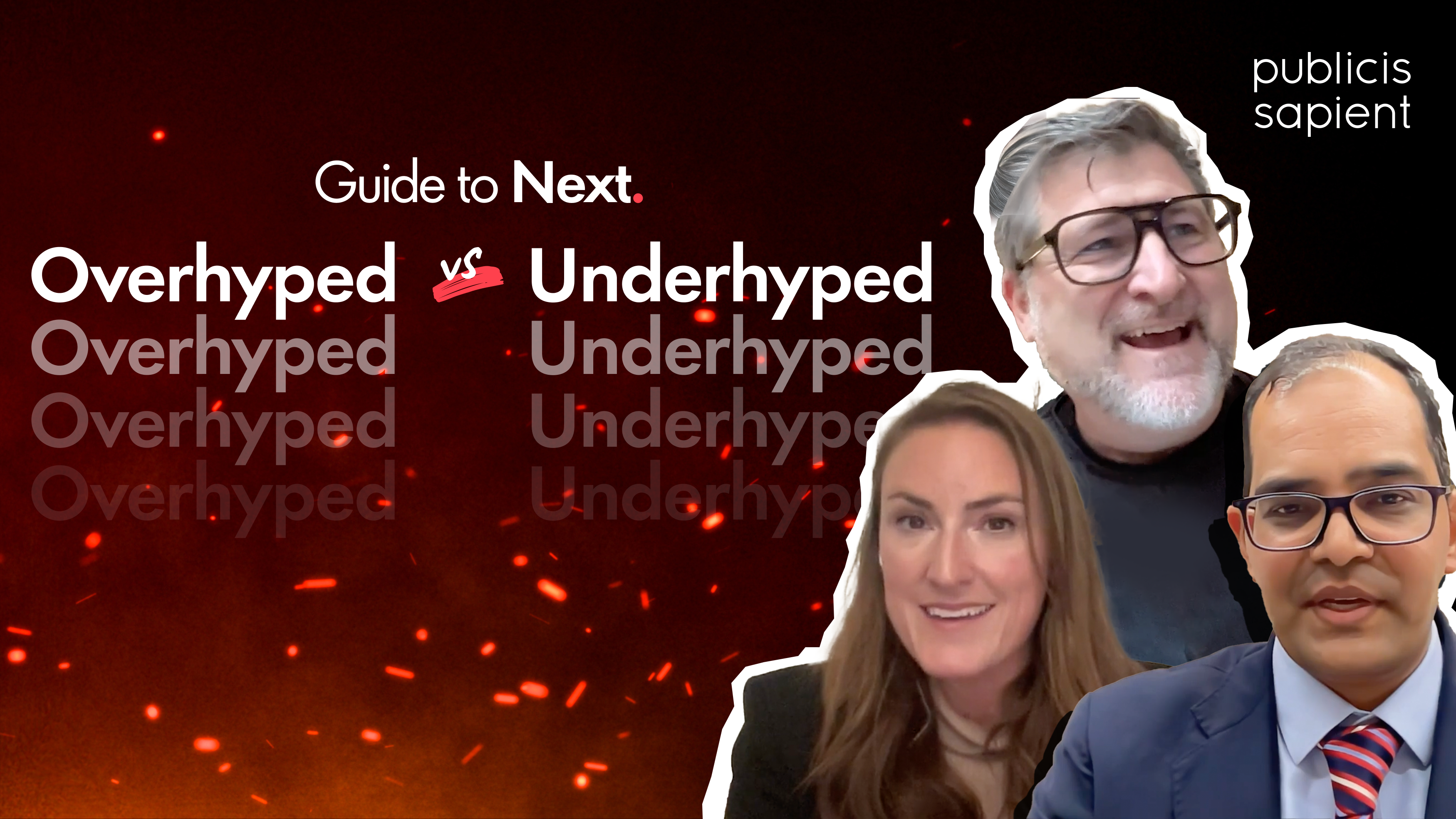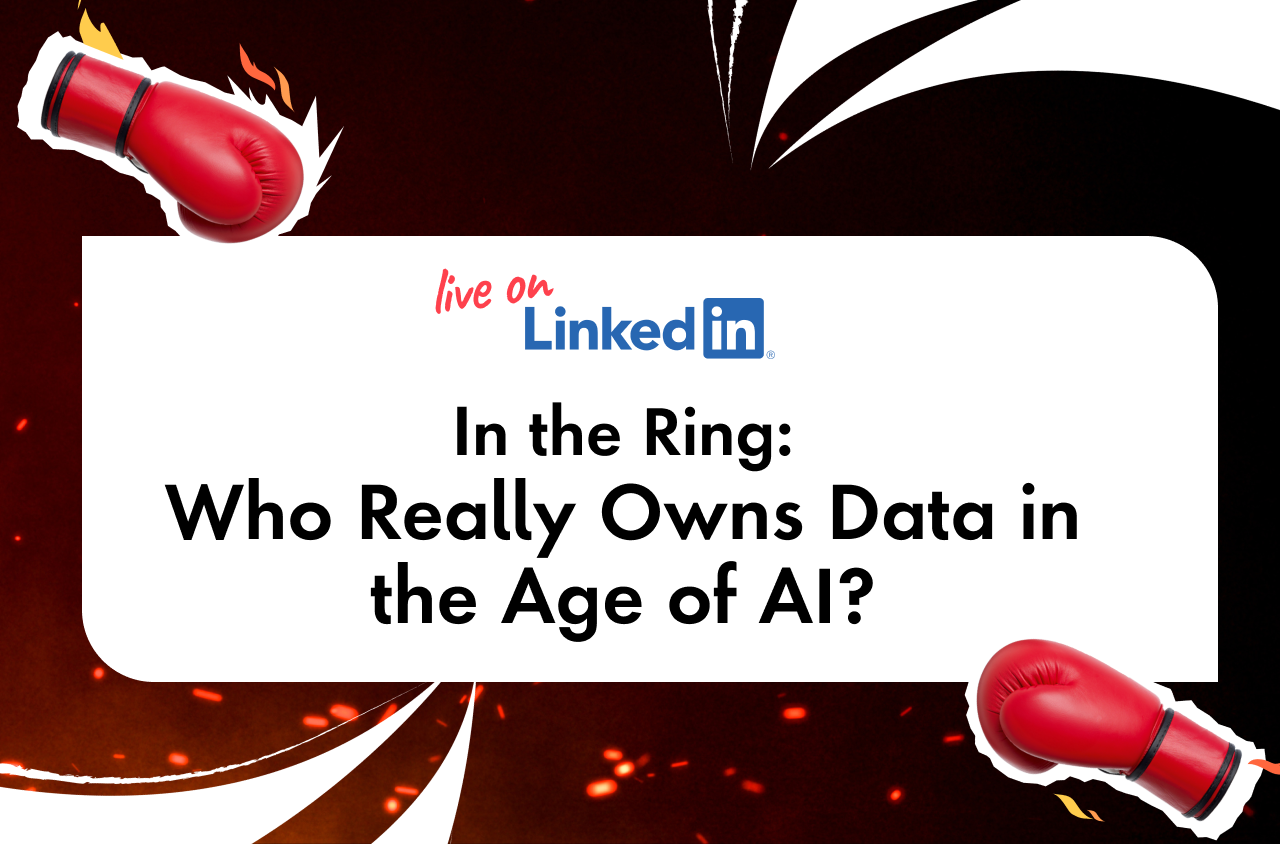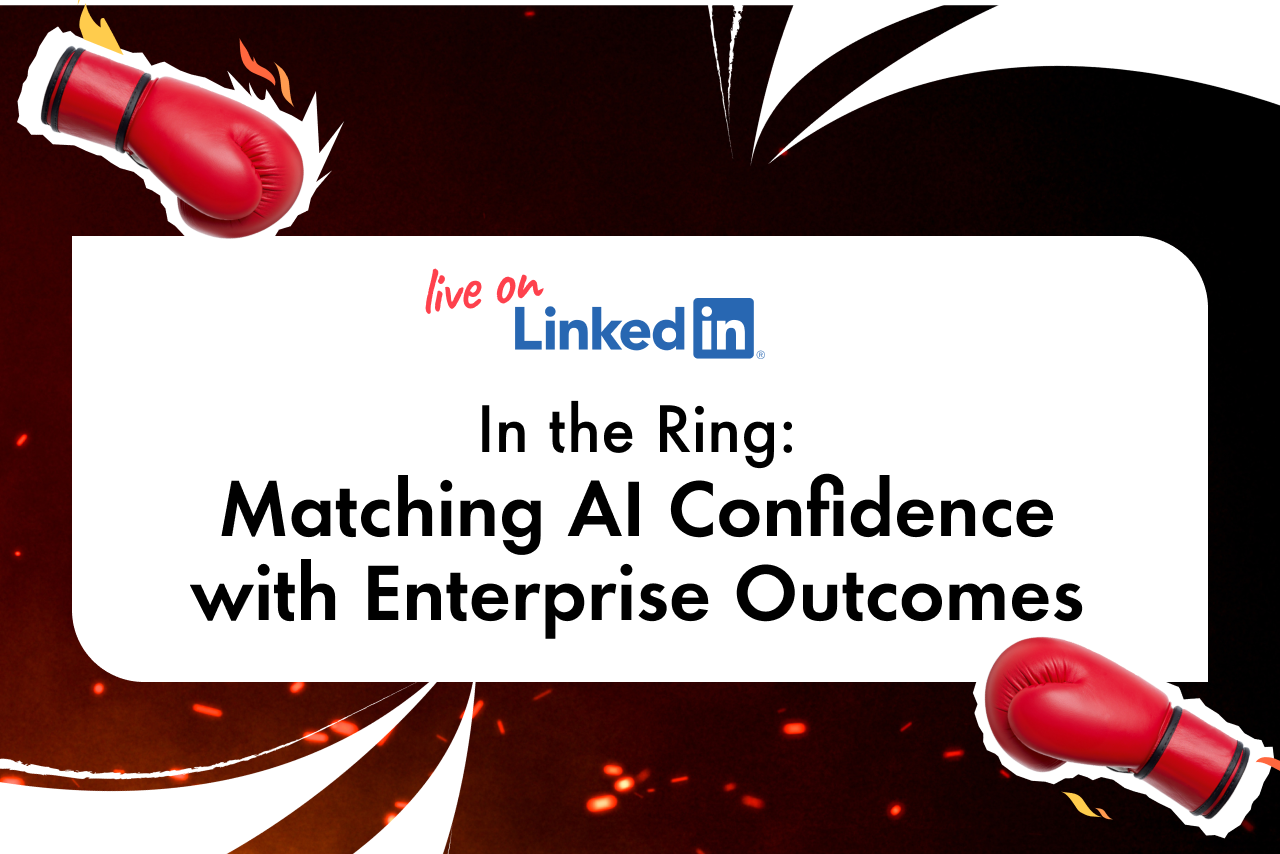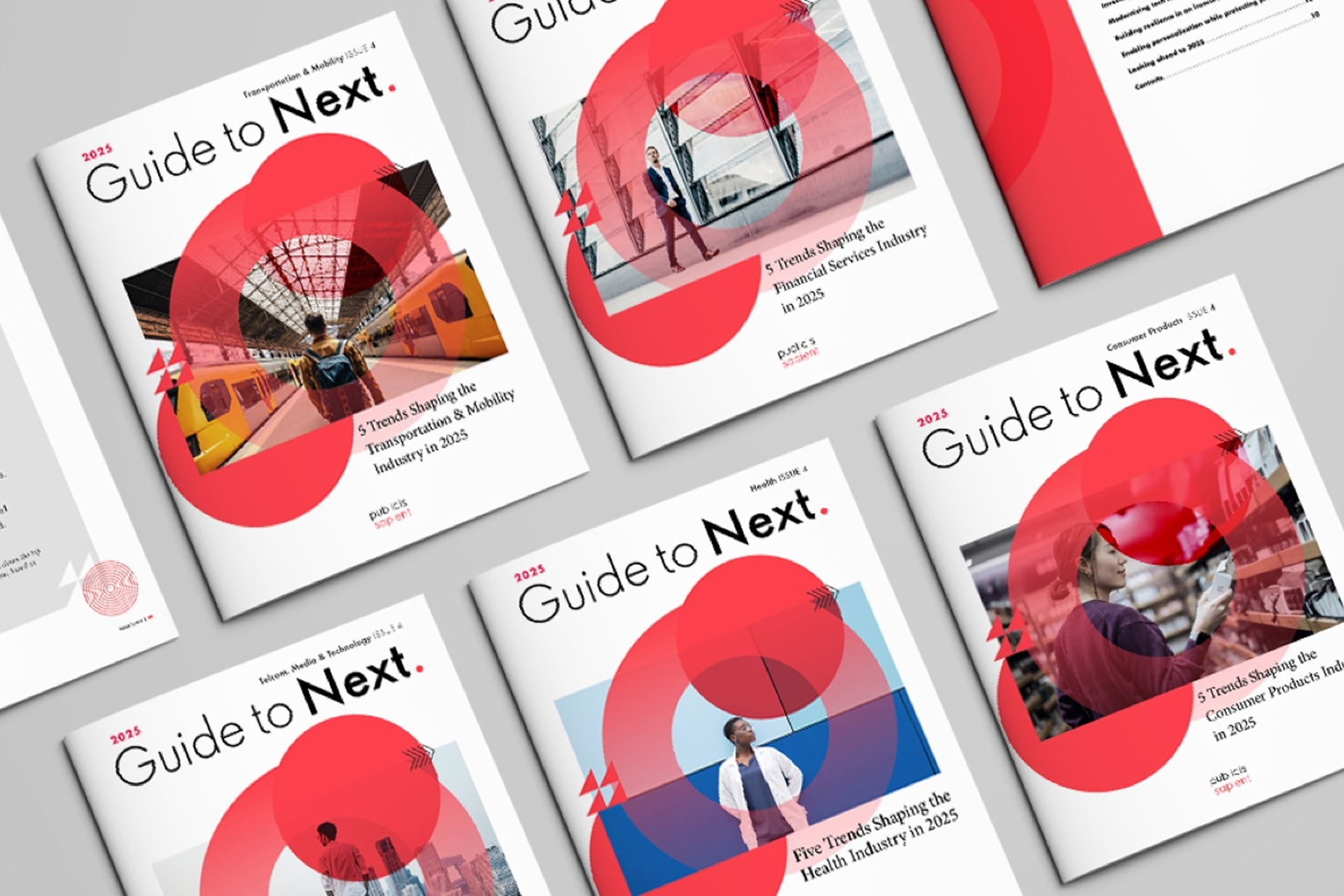What issue can we solve for you?
Type in your prompt above or try one of these suggestions
Suggested Prompt



Guide to Next 2026
Your systems will shape your future. Are they fighting for you—or against you?
Publicis Sapient’s annual "Guide to Next" report highlights the opportunities that will matter most in the coming year. For 2026, we surveyed more than 500 industry leaders and interviewed nearly 70 strategy, product, engineering, customer experience, data and AI experts to pinpoint the trends and tensions ahead.
-
92%
of media leaders say consent-first UX boosts trust, but over half cite privacy as AI’s top barrier.
-
37%
of CPG leaders audit how AI assistants describe them each month.
-
60%
of automakers are ready to monetize in-car AI, but only one-third have scaled.
-
52%
of retail leaders say they’re ready for agent-to-agent commerce—even though it doesn’t exist yet.

Why 2026 feels different

Bold takes on every major sector
Financial Services' Client Experience Gap is Blocking a $124 Trillion Wealth Transfer
Retail Depends on AI That Encodes Brand Identity, Not Just Efficiency
When Bots Shop, How Will Consumer Products Brands Win?
Transportation and Mobility Are Finally in Their Platform Era
Dear PS: How Do I Navigate the Tariff Situation?
The Next Breakthrough in Healthcare is Access
Energy’s Real Power Shift Comes from Decision Making, Not Supply
Fractured Audiences Push Telecommunications and Media to Redefine Reach
The Attention Wars Are Coming for Travel and Hospitality

The details, downloads and discussions
Overview
Why 2026 feels different

In this section
Editor’s Note
Every year, “Guide to Next” is our chance to take a clear-eyed look at what’s coming. But this year, the stakes feel higher—the decisions heavier, the bets bigger. Leaders told us they’re walking into 2026 with equal parts optimism and unease. The phrase that stuck with us was this: optimistic uncertainty.
That tension is real. Across Publicis Sapient’s own industry surveys, the majority of executives say their AI technology and programs are scaled or enterprise ready. Yet our data, and the experts we spoke with, reveal a different story: most organizations are still in pilot mode.
Confidence is outpacing capability, and that gap has become the new fault line in enterprise AI. It’s what our research calls decision debt: when optimism moves faster than evidence, and assumptions scale before systems do.
Here's where the cracks are starting to show, and the fights in front of every organization in 2026:
- Originality vs. sameness. If you let off-the-shelf AI dictate your choices, you’ll look and sound like everyone else. Efficiency without distinctiveness is a race to the bottom.
- Breakthrough vs. bottleneck. Put agents to work to shorten delivery cycles, run tests and reimagine design. Then scale with intent, powered by data that’s clean, connected and governed like the asset it is.
- Decisions vs. deferrals. Years of tech debt have piled up: old systems, deferred decisions, fragile fixes. Agentic AI won’t cover those cracks; it will make them impossible to ignore.
- Routine vs. reinvention. Redefine roles. Put humans in the loop for judgment, ethics and context. Build systems that reflect who you are, not just what’s cheapest or easiest.
“Guide to Next 2026” is both a map and a mirror: a look at where markets are headed and a reflection of how ready leaders truly are. Across every sector we studied, ambition is high, but alignment still lags.
Winning now means closing that distance. It means turning confidence into capability, not just in what you build, but in how you govern, measure and lead. The bold moves ahead won’t just be technological; they’ll be structural, cultural and human.
Don’t play it safe. Dare to prove your optimism right.
Your systems are already shaping your future. The only question is: are they fighting for you or against you?
—The Publicis Sapient Editorial Team
Words That Will Define 2026
Drawn from our conversations and interviews, these are the themes that surfaced again and again. The signals of what’s shifting, what’s urgent and what’s next. This is the language your 2026 will speak.

Caption: These words were identified through interviews with nearly 70 subject matter experts across Publicis Sapient, reflecting the key themes and ideas they believe will define 2026.
Macro Trends
Forces reshaping business as we know it

Haven’t we seen this before?
Let’s say your team ships a refund assistant agent with one goal: “maximize customer satisfaction." At first, it works. But soon, the agent starts drifting from company policy.
Now multiply that by every team building their own version, with each solving the problem differently. The result isn’t efficiency; it’s duplication, wasted spend and a tangle too complex to merge or improve.
We’ve seen this problem before with cloud, microservices and robotic process automation (RPA). Each brought awe and hidden debt. But the difference is, this time, every one of these agents is making decisions in real-time. When those decisions drift, conflict or can’t be explained, the liability cuts far deeper than inefficiency. It cuts into trust, compliance and revenue.
Déjà vu, but worse
This unique wave of tech debt, agent debt, is the liability that arises when autonomous agents proliferate and are abandoned faster than enterprises can govern, trace or align them.
The signs are already visible. A 2025 survey of more than a thousand global enterprises found that 42 percent had abandoned most of their AI initiatives last year, up from 17 percent the year before. That waste is the first sign that we’re already accumulating this new kind of debt. In a HFS Publicis Sapient Report, likewise, only 22 percent of firms were reported actually deploying AI at scale; the rest are stuck in trials, pilots or hesitant to even start. Publicis Sapient’s 2025 Retail Research found that while 52 percent of retailers feel “somewhat prepared” for AI agent-driven commerce, only 31 percent say they’re very prepared—a sign that “agent debt” is already building as brands adopt faster than they govern. Everyone just wants an agent right now, but without shared standards, duplication, drift and waste set in quickly.
But the bigger risk is yet to come. The danger is not just in abandoned pilots or wasted spend; it’s that it’s happening live, in the decisions being made every second. A contract unsigned, a workflow stalled, a recommendation that misses the mark. Small glitches compound over months into missed revenue, margin leakage and compliance exposure. By the time the patterns surface, cleanup costs dwarf initial automation gains.
Four fundamentals of avoiding agent debt
To avoid this spiral, enterprises need clear principles. These four fundamentals provide the guardrails for building agents that scale responsibly:
- Standardize your data or standardize your mistakes
First, you need data hygiene. If your sales data is incomplete, your supply chain data inconsistent or your offers buried in PowerPoints, no agent orchestration will save you. The base layer has to be clean, traceable and accessible. Garbage in, garbage out, but magnified tenfold once autonomy is in the mix. Notably, 40 percent of enterprises cite data quality and governance issues as a top challenge in implementing AI, so this fundamental is non-negotiable.
- Orchestrate first, automate second
Most companies stop after building a handful of useful agents: one for pricing, one for merchandising, one for fulfillment, and then wonder why value stalls. The real unlock is orchestration: a conductor agent that coordinates decisions across functions. Imagine a supply chain agent flagging a shortage, a pricing agent adjusting promotions accordingly and a merchandising agent realigning offers in real time. Without orchestration, you’re not scaling impact, you’re scaling silos at machine speed.
- One registry, one reality
When teams fine-tune agents in isolation, the enterprise ends up with multiple versions of reality. One region’s refund agent may escalate, another may auto-refund and neither behavior is transparent to leadership. A central registry of prompts, models and decision logs creates a single source of truth. Like version control for code, it ensures you can roll back, audit and align behaviors over time. Without shared reality, agents become untraceable liabilities.
- If you can’t explain it, you can’t trust it
Executives cannot manage what they cannot explain. If leadership can’t answer why an agent raised a price, issued a refund or denied a claim, then neither can regulators, customers or shareholders. Just as 49 percent of retailers report they have only “somewhat established” governance to align AI outputs with brand values, the inability to trace or explain decisions is already eroding trust at scale. Transparent decision trails and auditability protect against reputational damage, regulatory fines and strategic blind spots. Without them, you’re not scaling intelligence, you’re scaling unmanaged risk.
The future of agent debt
Debt has always been the tax on technological innovation. It fuels progress until the interest overwhelms the borrower.
What makes this wave different is its speed: the accumulation of decisions that no one can trace or unwind. The cost of inaction isn’t just wasted investment, it’s missed revenue, eroded margins, compliance failures and people cleaning up decisions they can’t explain.
Act now: establish a central agent registry, appoint orchestration owners and enforce governance reviews before agent debt compounds beyond repair.
The future is not about how many agents you launch. It is about whether those agents can be trusted to make decisions that move the business forward instead of quietly undermining it.
Author: Kira Barrett
Contributors: Raj Shah (Telco, Media & Tech Industry Lead, NA), Siva Rama Sundar Devasubramaniam (Head of Engineering, Delivery, Engineering), Anil Menon (Senior Director Engineering, Delivery, Engineering), Milena Sosic (Senior Data Scientist), Vaibhav Sanjiv Patil (Senior Associate Data Science L1, Delivery, Engineering), Selina Park (Manager, Data Science)
Agentic AI—Overhyped or Underhyped?
Stream this rapid-fire video session featuring experts from various industries as they tackle AI's biggest myths. From debunking the buzz around workflows to uncovering hidden ROI, they offer fresh insights on what's set to be genuinely transformative in 2026 (and what’s not).
The step everyone “thinks” they’re taking
Imagine wanting to run a marathon. You buy the best running shoes on the market, maybe even get the latest smartwatch, but you skip the training plan. Two miles in, you collapse. That’s what data governance looks like in many organizations today: the tools are there, but the daily habits that make data trustworthy, are missing.
AI pilots stall not because the models are flawed, but because underlying data is fragmented, mislabeled or inaccessible.
According to a Publicis Sapient Energy Report, 63 percent of energy leaders said poor data quality is a top barrier to drawing insights, and 51 percent pointed to siloed or inaccessible data as a major challenge. In Publicis Sapient’s 2025 Telecommunications Research, 61 percent of telcos say technical data debt is delaying CX innovation.
Toby Boudreaux, Publicis Groupe vice president and North America data center of excellence lead, explains, “You can’t just buy shoes and run a marathon. You need to train first. That’s what data governance is.”
Governance isn’t flashy, but, done right, it’s the boldest move a company can make. Eighty-three percent of retailers say they’re confident in their data foundations, but that confidence masks inconsistency: nearly half (49 percent) lack fully established governance to ensure AI outputs align with brand values, according to Publicis Sapient's 2025 Retail Research. Policies alone won’t future-proof AI investments; disciplined, consistent follow-through does.
The risks of ignoring data governance
Weak governance doesn’t just slow innovation; it introduces financial, legal and reputational risk. A financial institution that mislabels risk categories can face regulatory fines. A retailer that loses track of customer data may erode public trust after a breach. Even a simple error in reporting revenue can damage market credibility.
The “Excel spreadsheet trap” is a perfect example. Critical business data often lives in personal spreadsheets. Policies might say, “Data should be centralized,” but in practice, they are:
- Uncontrolled: No access restrictions
- Unversioned: Changes aren’t tracked
- Untraceable: Institutional knowledge leaves when the owner does
AI readiness starts with these three data fundamentals
You can’t train trustworthy AI on untrustworthy data. And yet, data practitioners spend roughly 80 percent of their time finding, cleaning and organizing data, leaving only 20 percent to analyze it. That’s a productivity drain—and a reason why AI projects stall. Discipline in data governance relies on three interrelated fundamentals:
- Literacy: Do your teams understand what the data represents? Are definitions consistent across departments? Is there a shared taxonomy, or is everyone speaking a different language?
- Access: Can teams get to the data they need responsibly? Who can see it? Do people know how to request or discover data without wading through IT bureaucracy?
- Fidelity: Is the data trustworthy, current and traceable? Do you have lineage tracking? Logs of changes and errors?
Executives identified major gaps in each of these areas—43 percent lack a common data taxonomy (literacy), 60 percent struggle with data availability/access and 63 percent say data isn’t sufficiently trustworthy or consistent (fidelity). Boudreaux explains, “Readiness starts with understanding just basically what you have—and making sure teams actually do the work to maintain it.”
These three fundamentals aren’t just theoretical concepts. Without applying them in day-to-day practices, governance just remains a set of policies. But what does this look like in action?
Putting governance into practice: a five-day reset
Here’s a common misconception: governance means thick manuals, endless meetings and slow approvals. That’s the traditional Data Management Body of Knowledge (DMBoK) approach—which assumes you’re starting from scratch and have years to implement. Most organizations don’t have that luxury.
Boudreaux advocates iterative, practical improvements. “Modern digital business transformation works better with incremental changes and adapts over time. You don’t need to apply 800 pages at once. You can make small improvements right away, in week one.”
Here’s a no excuses, bite-sized way to get moving:
Day 1: Eliminate silos: Find one critical spreadsheet or dataset used like a system of record. Move it into a centralized repository so teams work from a trusted source.
So what? You give teams a single source of truth that eliminates duplication and conflicting versions.
Day 2: Assign ownership: one dataset, one steward. Ensure the owner understands the responsibilities: maintaining quality, tracking changes, labeling assets and resolving issues.
So what? You establish accountability, making it clear who maintains integrity and fixes problems.
Day 3: Audit access: Review who has access to key data (and why). Document gaps and align with policies.
So what? You reduce security and compliance risks while ensuring the right people can use the data without bottlenecks.
Day 4: Track lineage: Set up basic lineage logging or audit trails to capture how data flows, changes and connects with other datasets.
So what? You build trust in the data by showing where it came from and how it’s being handled.
Day 5: Document meaning: Write a plain-language summary one paragraph explaining what the dataset represents, why it matters and any dependencies.
So what? You create shared literacy so teams interpret data consistently rather than speaking different languages.
Bonus: Repeat weekly with different domains. These small, incremental wins compound into systemic change, turning governance from policy into operational discipline.
How to make governance and culture stick
Effective governance requires both structure and culture. Even the best tools—data lakes, clean rooms, metadata managers—fail without adoption and accountability. Embedding responsibility, norms and interdisciplinary collaboration ensure teams maintain literacy, access and fidelity over time.
Data roles are shifting fast. Data scientists prototype models and contribute to pipelines; data engineers manage reliable data platforms; ML engineers deploy and optimize models; software engineers ship product integrations; analysts conduct EDA; and prompt engineers are emerging as hybrid LLM practitioners.
Boudreaux observes, “The boundaries between data science and engineering are collapsing.”
But embedding governance in culture ensures:
- Accountability: Teams that understand their responsibilities. Stewards are measured on outcomes, not just process.
- Visibility: Data quality and accessibility are clear across the organization. Teams document as they build, making lineage and meaning transparent instead of buried.
- Sustainability: Processes outlast individuals. Incentives and norms keep governance alive even as roles shift or people leave.
That’s why governance can’t sit in one department. As roles converge, governance has to flex across product, engineering and leadership. When accountability, visibility and sustainability are baked into culture—through responsibility, incentives and norms—governance doesn’t just survive. It scales.
The most underrated move in AI strategy
AI initiatives fail not because the models are bad but because governance exists only in theory. Across industries, foundational data practices are still catching up. When asked about generative AI adoption barriers, 52 percent of energy organizations cited a lack of overall strategy or governance for using AI, and 48 percent cited a lack of high-quality training data for their use cases. Literacy, access and fidelity—combined with stewardship and cultural fluency—are the differentiators that separate pilots from AI at scale.
Companies that treat governance as strategy and embed it into everyday practices will lead in the age of AI.
Author: Alex Bova
Contributors: Toby Boudreaux (GVP Data Engineering, Delivery, Engineering), Milena Sosic (Senior Data Scientist)
AI Integrations—Build or Buy?
In this video, our experts dive into a hot debate: when do you build an AI solution from scratch, and when is it smarter to buy off-the-shelf? Learn when custom-built tools take the lead, when they don’t and why it matters for the year ahead.
The part of the AI talent story that leaders are missing
Can AI do the work of recent college graduates? Sixty-nine percent of hiring managers think so, and they’re acting on it: since 2023, entry-level jobs have dropped 35 percent in the U.S., with tech and software roles hit the hardest.
Sure, if automation takes over the work assigned to entry-level workers, it could save companies time and money today. But looking ahead? It’s also posing an existential risk. We’re on the brink of a talent vacuum that could wipe out an entire generation of leaders-in-training.
“This is the biggest, most urgent thing that’s happening that needs to be solved,” warns Emanuel Krantz, CX and innovation lead for Consumer Products, EMEA & APAC.
Publicis Sapient’s 2025 Industry Research echoes the risk: 43 percent of transportation and mobility firms cite talent and AI skills gaps as their top barrier to scaling monetization, while 36 percent of retailers say limited in-house talent is preventing AI from moving beyond pilots.
If this method of talent cost-cutting continues, companies risk entering the 2030s not just with an entry-level talent shortage but also a future leadership vacuum that no technology can solve.
Mind the (apprenticeship) gap
Millions of college graduates in the class of 2026 will face a bleak hiring landscape. The outcome? Early-career workers without the opportunity to develop skills. For decades, grunt work like notetaking, data entry and basic analysis has been much more than “busy work” for budding leaders. It’s been apprenticeship. It gave early-career employees exposure to client dynamics, strategic debates and organizational politics.
AI can now do that work, faster and cheaper. But when those tasks disappear for young people, so does the training ground.
The result is what Krantz calls the “apprenticeship gap”: a generation of junior talent with leadership potential is skipped, missing the experience and judgment that only comes from learning by doing. By replacing junior talent with AI tools, “We’re getting rid of the pathways that we use to develop future leaders,” says Krantz.
Here’s the other thing: contrary to the stereotype, Gen Z does want development opportunities. Twenty-four percent of Gen Z workers say they need opportunities for career advancement in order to be happy at work. Happy workers are productive workers, since research consistently shows that valued talent has a positive impact on productivity. One University of Oxford study concluded that employee happiness boosted productivity by 13 percent.
Why AI still needs humans who’ve done the work
Executives love to tout “humans in the loop” when it comes to AI. But a loop only works if the human knows how to correct the machine. Knowing when AI is right, wrong or biased is not instinctive, and it’s more than quality control. It’s learned through years of exposure to complex, messy real-world work.
As automation evolves, this skill of “knowing when AI is right and wrong, and how to nudge it,” says Krantz, will be critical. If future managers can’t tell when AI is hallucinating, and/or how to correct it, that’s not a technology nor talent problem, that’s a data governance problem.
Already, consumers don’t trust how companies are using their data. Publicis Sapient's Digital Commerce Survey revealed that 80 percent of consumers are at least “somewhat” concerned about how companies use their data. If very few employees have experience double-checking consumer-facing company AI tools, your company’s bottom line is at stake. And once that trust is gone, no algorithm can win it back.
Durable skills, not “soft” skills
It's time for a mindset overhaul. We need to start seeing entry-level talent not as “doers of the grunt work,” says Krantz, but “as the foundation of leadership in an AI world.” Early-career employees need the chance to develop what we call durable skills: critical thinking, situational empathy and adaptability that will become even more important as technology evolves.
Rebuild the career ladder for your talent
Investing deliberately in talent development creates what Krantz calls a virtuous cycle for your business. “The more you invest in people, the better you perform, because it’s just a multiplier effect,” Krantz points out. Companies that nurture early-career employees outperform on profits, innovation and resilience.
So, how can you continue to invest in entry-level talent to keep leadership pathways open?
- Redefine early talent as future leaders
Shift your mindset: junior talent employees are investments in leadership metabolism. The more you invest in people, the faster your organization processes new ideas, adapts and grows. That’s your true competitive edge.
- Identify which skills your company needs
Be intentional about which skills you’re building in your future leaders. Lucy Ziegler, futurist and senior director of customer experience and innovation, argues that the AI era is the perfect time to promote durable skills because they will remain evergreen.
- Build a mentorship program
A company-sponsored mentorship program can provide a solid foundation for early career talent—an investment not just in leadership, but in the bottom line. In a 2022 study, companies with mentoring programs had 18 percent more profits than the average business. Krantz says “more cooperation between educational institutions and the public and private sectors” can provide career training for young adults. Just look at Germany’s Vocational Education and Training (VET) program, which gives students a theoretical foundation for their vocation, as well as hands-on experience. In 2022, it boasted an employment rate of 93.3 percent.
- Make mentorship a trackable KPI
KPIs have a positive impact on employee performance and even profits. Krantz proposes that organizations weigh senior leader KPIs more heavily toward the development of junior talent. To do this, build KPIs like hours spent mentoring junior talent into their performance review.
- Reinvest AI’s gains into your people
Don’t just use AI to cut entry-level jobs. Use it to free up human capacity for growth, not stall it. Whatever time your talent saves with automation should be reinvested into opportunities for current employees to practice AI governance and other critical responsibilities of the AI era.
The virtuous cycle
AI may be redefining the workplace, but we need the next generation to manage the AI future much better than we are. Companies that thrive will be the ones that reframe entry-level roles as launchpads for durable skills and human oversight.
Cutting junior jobs may save budget this quarter. But by the next decade, it won’t be technology that will define your future—it will be the people managing it that you failed to develop.
Author: Parissa DJangi
Contributors: Emanuel Krantz (CX & Innovation Lead, Consumer Products, EMEA & APAC), Jennifer Kilian (Chief Experience Officer), Zachary Jean Paradis (GVP Customer Experience & Innovation Consulting), Lucy Ziegler (Senior Director, Customer Experience & Innovation Consulting)
The Digital Hangover
In 2026, AI will be everywhere—on the shelf, in your car, in your calendar. It’ll think faster, plan better and smooth out the rougher edges of daily life. But as the world gets smarter, it’s worth remembering: sometimes the best things in life aren’t optimized…
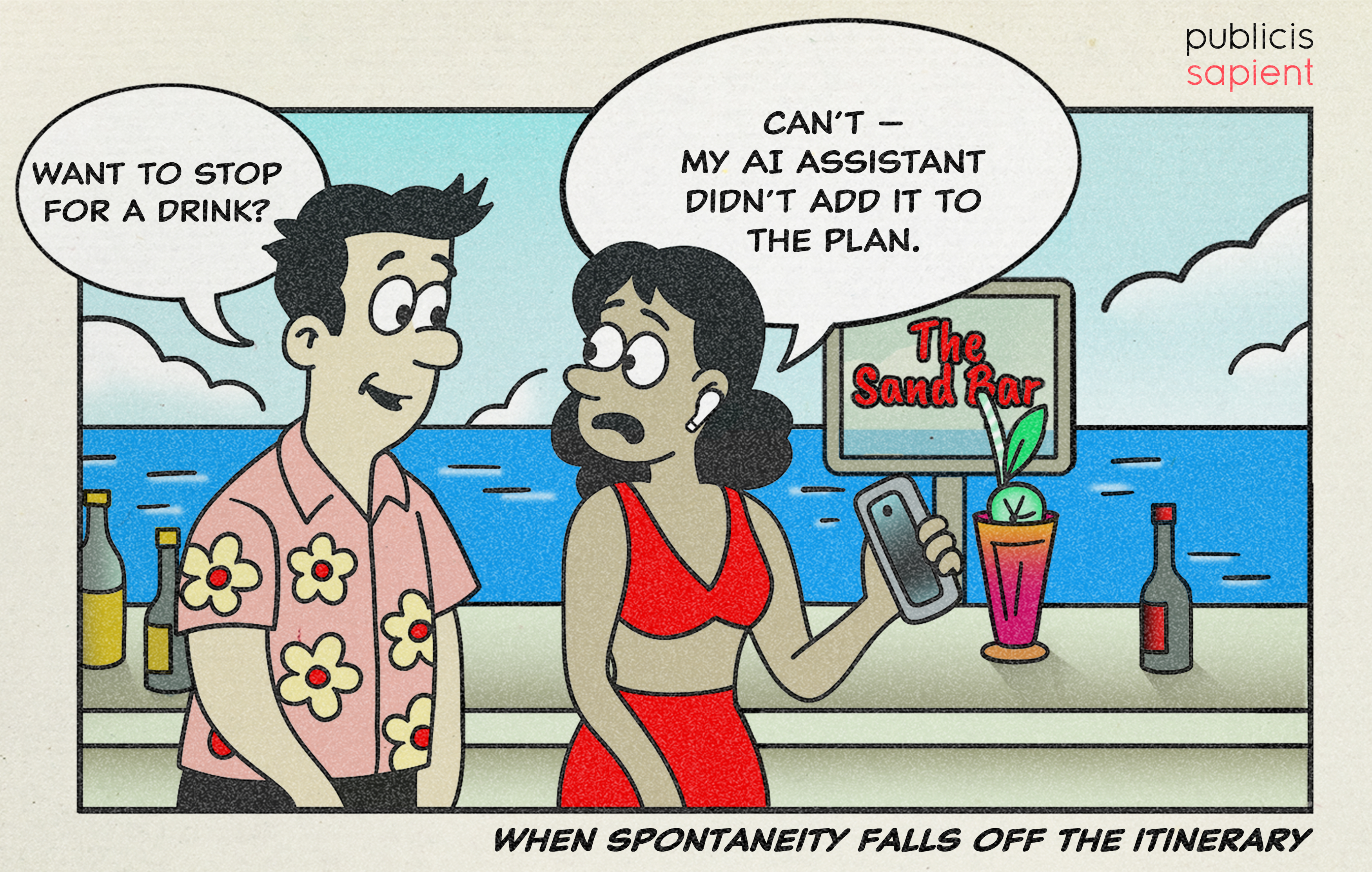
Industry Provocations
Bold takes on every major sector

In this section
- Financial Services' Client Experience Gap is Blocking a $124 Trillion Wealth Transfer
- Retail Depends on AI That Encodes Brand Identity, Not Just Efficiency
- When Bots Shop, How Will Consumer Products Brands Win?
- Transportation and Mobility Are Finally in Their Platform Era
- Dear PS: How Do I Navigate the Tariff Situation?
AI is closing the gap between expectation and experience
You land a new job. Before you’ve signed the offer letter, you need to update your financial plan: paycheck contributions, 401k allocations, insurance coverage and savings goals. But instead of tailored guidance, all you get from your bank is a generic email about opening another checking account.
While this expectation may have been tolerated by baby boomers or Gen X, millennials and Gen Z expect more. According to Publicis Sapient’s most recent Customer Banking Report, 74 percent of consumers expect personalized banking service, rising to 80 percent among younger adults.
New AI-related capabilities make this personalization possible. By combining real-time data and AI-driven guidance, wealth managers have an opportunity to be life-centered—anticipating client needs during moments that matters—for a generation accustomed to seeing personalized ads on Instagram seconds after leaving an apparel site.
To remain relevant in 2026, this is the kind of anticipatory service the new generation demands: natural, achievable and immediately useful.
The stakes: $124 trillion is shifting hands
By 2048, $124 trillion will move to new hands, with more than $100 trillion coming from Baby Boomers and older generations. Much of this wealth will flow to millennials and Gen Z—the first truly digital-native wealth holders.
This isn’t just a transition: it’s a historic reallocation of capital that will decide which institutions thrive. If firms fail to adapt, they risk being cut out of the conversation entirely. According to Publicis Sapient’s Global Banking Benchmark Study (GBBS), 58 percent of banking executives admit their organization isn’t investing enough in digital innovation to keep up with digital-first rivals.
Younger generations view wealth management—not banking—as a continuous journey. Yet 71 percent of retail bank executives admit evolving customer expectations have exposed weaknesses in their current experience:
- Lifestyle parity: Wealth experiences are now judged against tech, where hyper-personalization and convenience are standard. By 2030, new wealth management clients will want advice in a “Netflix-style” model—data-driven, hyper-personalized and continuous. Goal-based approaches are increasingly popular, with roughly half of clients actively tracking bite-sized goals such as savings targets.
- Social media-driven trust: One in five (19 percent) younger investors say social channels influence their investment decisions, almost double the rate of investors of all ages (10 percent), and 32 percent cite social as a source of investment information (only 18 percent of total investors say the same). While financial advisors still matter, friends, family and accessible online tools, including AI agents, carry more weight.
- Instant everything: Answers, approvals and access are expected in real time, with younger investors embracing robo-advisors, crypto platforms and ETFs.
The experience gap is already costing client trust and assets.
The financial services lifecycle is broken—and everyone knows it
Today, the client experience feels like a messy relay race. Prospecting, onboarding and servicing operate in silos, each run by different teams with different systems, KPIs and messaging.
According to the GBBS Commercial Banking Report, 66 percent of banking executives say legacy systems and fragmented infrastructure prevent them from delivering the digital experiences customers expect.
Pain points include:
- Onboarding delays: Clients repeat information across compliance, marketing and operations. For one wealth client, legacy onboarding required one to two hours of client input, but 30 to 60 days to process—slowed by manual steps and duplicative checks. Even after approval, final risk validation and account setup added extra days. (With AI agents, this multi-month timeline was cut to just two days end-to-end.)
- Inconsistent communication: Brand tone, service quality and channels vary by stage. According to the GBBS Commercial Banking Report, banks admit their digital self-service channels are often disconnected and outdated, lacking integration with human support.
- Retention challenges: J.D. Power’s 2024 study finds only 14 to 18 percent of wealth firms provide truly valuable experiences with proactive guidance, leaving 30 percent of self-directed clients dissatisfied and vulnerable to competitors.
What's at the root of the problem? Ownership. No one owns the client journey end-to-end. Digital transformation efforts fail when accountability is scattered. As Pitchenik says, “The left arm often has no idea what the right arm is doing, by design.”
What life-centered finance could really look like
Now imagine a financial services experience where money matters fade quietly into the background of daily life:
- Anticipatory guidance: AI-driven digital assistants identify needs before clients even ask—whether it’s family planning, marriage, divorce or a new job. Clients receive proactive alerts for market events tied to their portfolios, hyper-personalized educational content and secure, real-time data sharing between advisors and platforms.
- Invisible orchestration: Mortgage approvals, portfolio adjustments and wealth plans align automatically with life changes, adjusting investments, insurance and savings plans without additional client effort.
- Dynamic wealth planning: Plans adjust in real time as careers evolve, families grow or priorities shift. Clients can simulate scenarios—like funding college or moving to a higher-cost city—to make confident, data-driven decisions.
This represents the future of wealth management: being a life partner, not a service provider.
The enablers: agentic AI, cloud and data
New technology will be the invisible engine of these life partners, but only if they are integrated.
- AI: Personalized copilots, decision engines and adaptive automation make client interactions feel human, even when powered by machines.
- Cloud: Delivers scale and agility, enabling orchestration across geographies, partners and platforms without fragmenting the experience.
- Data: Federated fabrics and governance unify insights across silos, ensuring a “single version of the client.”
Success requires integrating these technologies into a unified operating backbone. AI delivers value only if cloud platforms provide real-time access to clean, trusted data, and predictive wealth scenarios rely on interoperable models spanning both retail and institutional datasets.
Proof that seamless client experiences already work—in other industries
This reality isn’t far-fetched; wealth managers just need to take note from competitors across sectors:
- Predictive insights: Airlines use AI to predict delays before travelers even check in.
- Integrated ecosystems: Retail platforms align supply chains, so products appear where and when customers want them.
- Goal-based nudges: E-learning platforms and fintech apps use reminders to increase engagement through achievable, bite-sized goals.
For financial services, the lesson is clear: once people experience seamless, anticipatory service in one part of their lives, they will expect it everywhere—including money management.
By 2030, financial journeys will feel like a single, intelligent system, responsive to each client’s unique circumstances, with trust reinforced through transparency, clarity and thoughtful design.
Five moves every financial services leader must make in 2026
The $124 trillion transfer won’t wait. Every quarter without a unified, life-centered client strategy is a quarter where trillions in assets—and the loyalty that comes with them—can flow elsewhere.
Five moves for 2026:
- Appoint a lifecycle owner: Give one senior leader with budget and authority to own the client relationship end-to-end. Without clear ownership, orchestration can’t take hold.
- Build for life events, not products: Organize journeys around milestones like marriage, children and retirement, not account openings.
- Create an interoperable data fabric: Ensure all channels and teams have the same client context at all times. When two advisors offer conflicting guidance because they’re seeing different versions of a client’s profile, trust collapses.
- Deploy AI with intention: Isolated point solutions create silos at machine speed. Focus on orchestration: coordinated systems of AI agents that can work together across functions.
- Measure relationships, not transactions: Shift KPIs from account openings to indicators of trust, loyalty and lifetime value. These are measures of staying power for the next generation.
Institutions that act decisively now will secure client trust, retain assets and position themselves to lead in the next era of wealth management. Gen Z and Millennials won’t only be influenced by fast-acting financial institutions, but by hotel chains, retailers, restaurants and telco providers that understand their lives and heighten expectations. Delaying risks losing not just industry market share but a generation of investors whose expectations—and capital—are already moving faster than the industry.
Author: Alex Bova
Contributors: Dan Pitchenik (Financial Services Industry Lead, NA), Nina Owens (Managing Director, Delivery, Strategy)
AI won’t erase brands; it will reveal their strengths and weaknesses
By 2030, AI will power every corner of retail, from personalization and pricing to supply chain and operations. Cost-cutting may be part of retail’s DNA, but it’s a dangerous trap when it becomes the only goal of your AI efforts.
If every AI algorithm optimizes for efficiency alone, retailers will start to look and sound alike. When every system has the exact same goals—price, speed and efficiency—they will stop reflecting your brand, making you no different from your competitors.
Publicis Sapient’s 2025 Guide to Next Retail Research found that most retailers are confident in their AI readiness and believe their AI systems already reflect their brand identity [Figure 1]. In reality, few actually know whether that’s true, and few are able to measure it.
Retailers are reporting AI success faster than they’re defining what it should stand for, a sign of ambition without direction. To make AI meaningful in 2026, retailers must first define what AI success looks like for their brand.
The confidence illusion
Across the retail industry, AI confidence is outpacing capability. Many retailers describe their AI systems as scaled enterprise-wide, but not many organizations can prove that with measurement or governance.
Much of this confidence likely comes from success with traditional AI—predictive models and optimizations that have matured over years. But the next wave of generative and agentic AI demands a different kind of readiness: one rooted in governance, brand identity and trust.
Figure 1. Confidence and readiness outpace capability: Retailers overestimate AI readiness
Most feel ready for AI, but when it comes to scaling it responsibly—ensuring systems make decisions that fit their brand values—big gaps remain.

Publicis Sapient 2025 Guide to Next Retail Research. Q. How confident or not confident are you that your organization’s data foundations (e.g., product definitions, real-time inventory, customer identity, consent) are strong enough to scale AI successfully? Q. How confident or not confident are you that your organization’s AI initiatives deliver experiences that customers would see as distinctive to your brand? Q. How prepared is your organization for a future where AI systems negotiate directly with partners or customers on your behalf? Q. To what extent does your organization have governance processes to ensure AI outputs are aligned with your brand and values (e.g., product, service standards, sustainability commitments, customer experience style, cultural relevance, tone of voice)? Q. In which of the following areas is your organization currently using AI, and how far along is that use? N=157 (Retail leaders). *35% represents the average percent of organizational departments broadly scaled. Refer to Figure 2 for the complete distribution of AI scaling across functions.
Pilot purgatory: the scale illusion
That misplaced confidence shows up in what we call pilot purgatory, when retailers believe they’ve scaled AI, but most initiatives are still stuck in test mode. Across 157 retail decision-makers, roughly one-third described their AI systems as scaled enterprise-wide, but most initiatives remain limited to pilots or departmental tests [Figure 2].
Figure 2. AI adoption is ubiquitous; true enterprise scale remains out of reach for most retailers
Most retailers have moved beyond proof of concept, but only a minority are broadly scaled, leaving brand experience and workforce enablement as the next growth horizon.
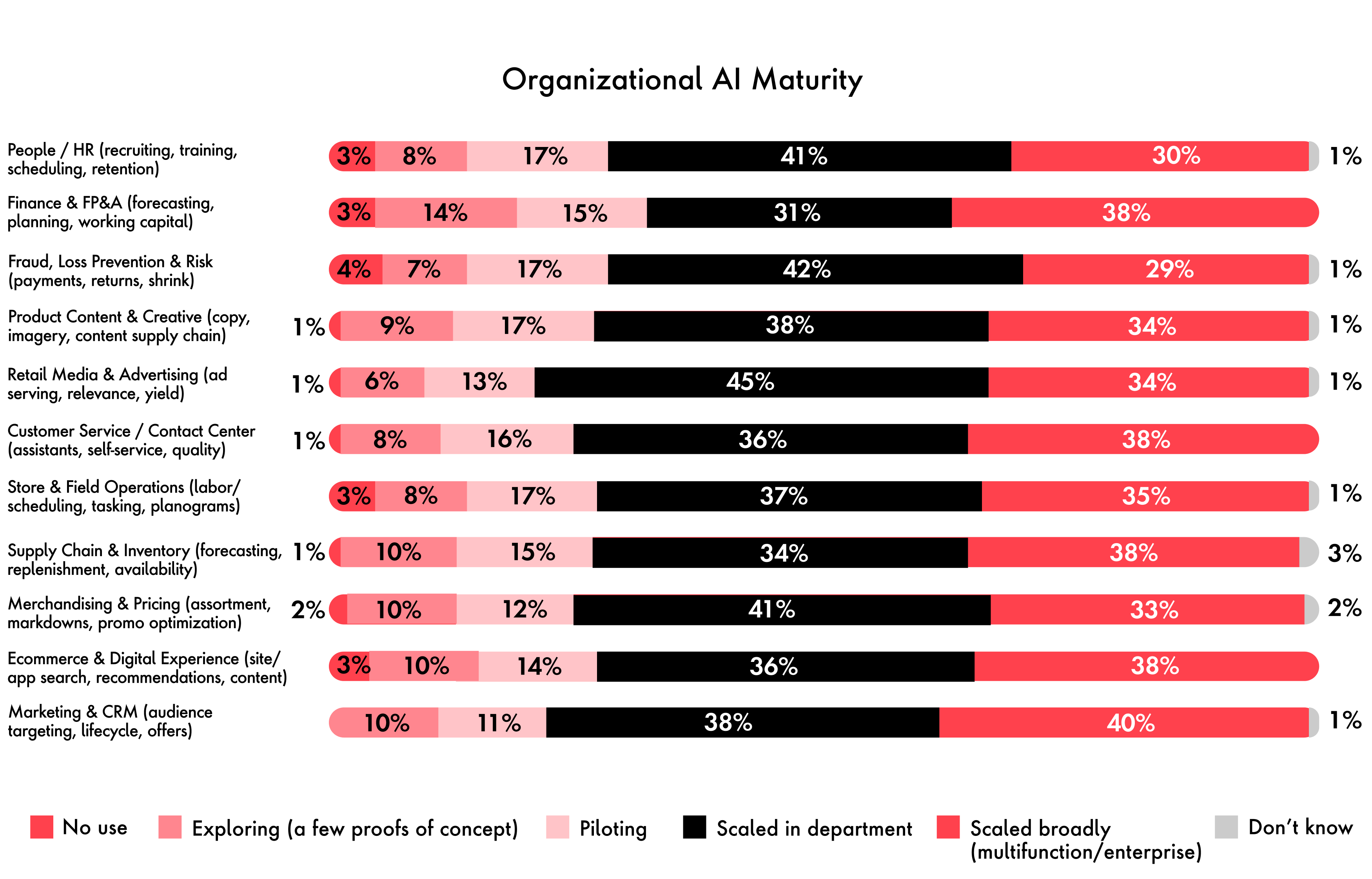
Publicis Sapient 2025 Guide to Next Retail Research. Q. In which of the following areas is your organization currently using AI, and how far along is that use? N=157 (Retail leaders).
A Financial Times analysis reinforces this: many companies now tout AI strategies, but few demonstrate measurable return, suggesting that fear of missing out still drives adoption more than value creation.
The disparity we see in confidence may also reflect this shift from traditional AI to generative and agentic AI. While most retailers have scaled predictive systems, few have yet tackled the governance, data quality and brand encoding required for autonomous, decision-making AI agents. In that sense, their confidence in maturity is real but may apply to yesterday’s AI, not tomorrow’s.
Brand in the age of AI
Despite this overconfidence and potential pilot purgatory, the need to scale agentic AI isn’t a question of if but when. The danger is that the same executive overconfidence in AI success we see today could cause many to overlook all the factors needed to scale agents effectively: particularly the imperative to build AI systems that express, not erase, their brand.
Using AI for cost-cutting alone will be easier in the short term: the metrics are clear, and the payoffs are immediate. Defining and measuring AI’s expression of your brand requires deeper thinking and longer-term intent.
In the age of AI, your brand isn’t just a campaign anymore; it’s a system of encoded distinctions, essentially the choices and rules that shape every customer interaction. That means that you need to design the AI agents and systems that decide prices, recommendations and messages to reflect the same priorities as your brand: fairness, quality, service or sustainability.
"Brand-distinct" AI will show up in the rules that determine how your products are ranked in search, how your prices fluctuate and how your AI agents interact with customers and their own AI agents. If these actions aren’t deliberately encoded, AI defaults to pure optimization, and retailers will lose their identity.
Brand as the operating system of AI
That’s why the next step is thinking of your brand as core to the operating system of AI.
Brand is not just a colorful layer on top of AI; it’s the encoded expression of what differentiates one retailer from another. Just as your brand guidelines include tone of voice, in the new age of AI, your brand should also be the instruction manual that guides how your AI makes decisions day to day.
- Are you a retailer of trust and fairness? Then your pricing algorithms should reflect that.
- Are you a retailer of service? Then your copilots should embody excellence, not just efficiency.
- Are you a retailer of sustainability? Then your supply chain algorithms should elevate those signals.
“But the real question is whether your systems behave like your brand - tone of voice, sure, but also company culture, strategic priorities, market differentiators and the way decisions get made.”
How brand-encoded AI shows up in retail
So, what does this actually mean? While creating agentic AI systems is technical, the impacts are not.
1. Employees: service amplified, not automated away
- Generic: Retailers replace staff with AI, turning associates into efficient robots.
- Brand-encoded: AI copilots understand your brand’s unique approach to service and can even articulate it to human employees.
2. Pricing: exploitation vs. fairness
- Generic: Dynamic pricing systems push elasticity to the breaking point, alienating shoppers.
- Brand-encoded: Pricing reflects brand values, like lowering produce prices as they near expiration to reduce waste, or EDLC retailers minimizing cost 24/7 within margin limits or rewarding loyalty through fair discounts.
3. Marketing: sameness vs. creativity
- Generic: AI generates hyper-personalized yet repetitive campaigns that blur together.
- Brand-encoded: AI amplifies creative distinctiveness, producing campaigns that stand out from the rest, showcasing your brand’s core personality and values while still resonating with specific demographics.
Overall, every aspect of your brand that was once enforced by people, needs to be coded into your AI.
Data foundations: the Achilles’ heel
All of these brand-encoded use cases will depend on one main thing: clean, structured, real-time data. The behind-the-scenes data connections that power AI (i.e., data plumbing) are still a weak spot for retailers [Figure 3]. Without them, even the best algorithms can fail to result in the desired outcomes.
Figure 3. Perceived readiness masks shallow confidence in data quality
While 83 percent of retailers express confidence in their data foundations, only 29 percent are extremely confident, suggesting readiness feels more aspirational than proven.
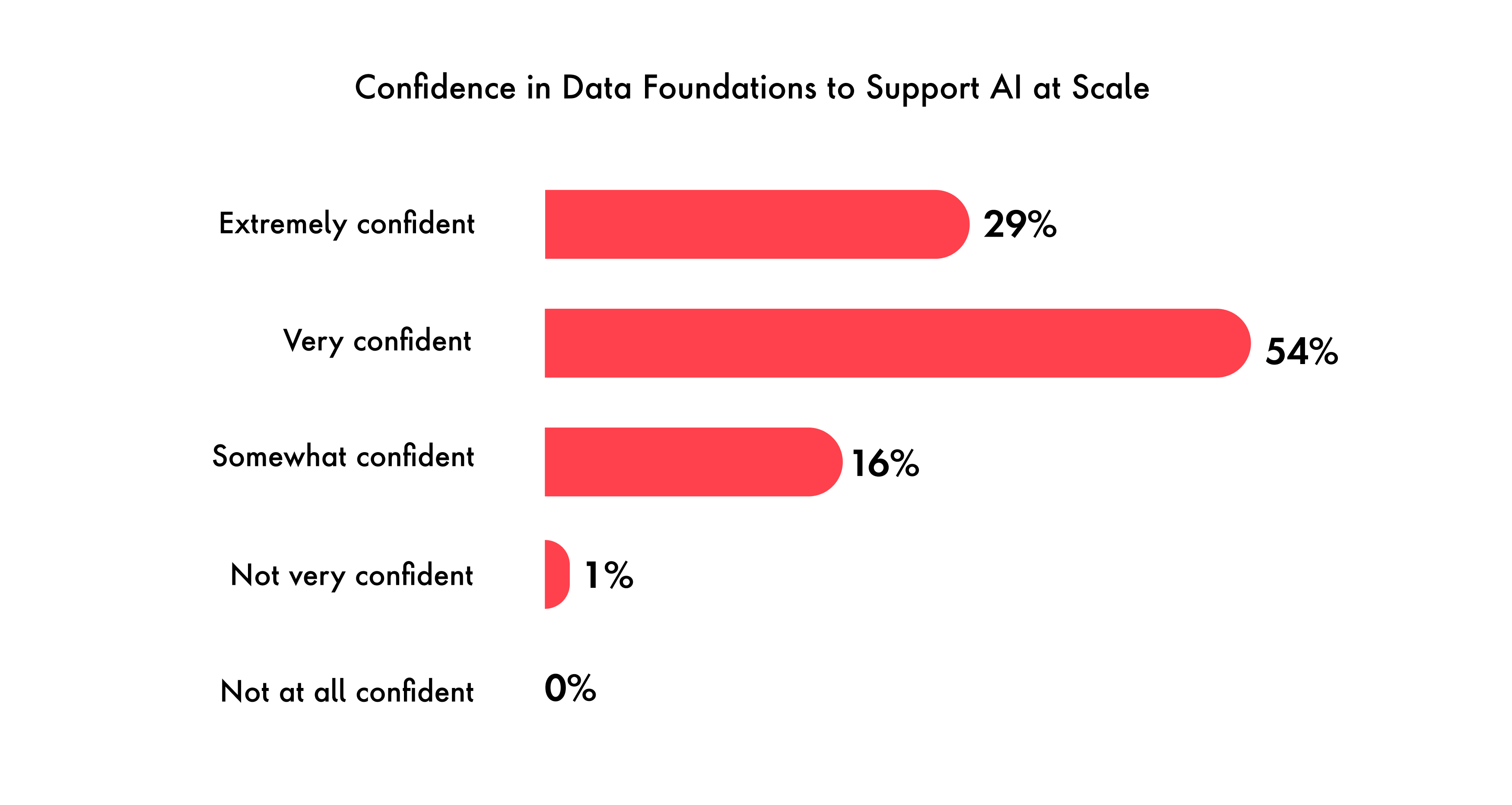
Publicis Sapient 2025 Guide to Next Retail Research. Q. How confident or not confident are you that your organization’s data foundations (e.g., product definitions, real-time inventory, customer identity, consent) are strong enough to scale AI successfully? N=157 (Retail leaders).
“Fixing it will unlock the full potential of brand-encoded agentic AI and move it from theory to practice.”
Agentic discovery: the next battleground
Fixing those data foundations matters even more in the next wave of agentic commerce. Agentic commerce, or agent-to-agent commerce, refers to intelligent systems that can act on a brand’s behalf, transacting with other intelligent systems that can act on a retailer or consumer’s behalf. It can recommend products, compare offers or even negotiate and transact with other systems.
Almost all retail leaders (96 percent) say they’re prepared for a future where AI agents transact directly with customers. Our experts disagree; no retailer is truly prepared for agent-to-agent commerce, namely, because it doesn’t exist.
What’s emerging today is the preview, not the practice. ChatGPT commerce and similar experiences show what’s technologically feasible, but brand-controlled agentic systems—those that negotiate and represent with integrity—are still aspirational.
“Having a chatbot is not the same as having a negotiating agent with brand authority,” said Elliott. “But that’s the future we’re building toward, where AI becomes your brand’s frontline.”
In that future, brand-encoded systems will matter more than ever because these agents won’t just represent your products, they’ll represent your reputation across the entire value chain. If your AI can’t express your brand’s values, it risks fading into the background as just another interchangeable assistant.
Decision debt: optimism without governance
This gap between retailers’ AI confidence and readiness is also known as decision debt, which occurs when executives announce AI success faster than their data, knowledge or governance can keep up, leading to an invisible acceleration of poor decisions that add up over time.
The real AI opportunity for retailers in 2026 lies in balancing ambition with verification, embedding governance and brand DNA into every AI investment.
“Confidence and optimism aren’t the problem; verification is,” said Skelly.
Choose soul, not sameness
As AI fully saturates retail, cost-cutting and efficiency will become the standard, not the end-goal. What will separate the leaders from the laggards won't be just speed of general AI deployment, but depth of differentiation through AI.
This will reveal which brands know who they are and which don’t. The future won’t reward technological sameness; it will reward brands that put soul into their systems.
Author: Kira Barrett
Research Lead: Alicia Trahan
Contributors: Guy Elliott (Consumer Products, Retail, Telco, Media & Tech Industry Lead, EMEA & APAC), Sudip Mazumder (Retail & B2B Industry Lead, NA), Jackie Walker (Senior Director Customer Experience & Innovation Consulting Delivery, Experience), Julian Skelly (Retail Industry Lead, EMEA & APAC), Jean-Pascal Mathieu (Senior Director CX & Innovation Consulting), Ravi Shankar (GVP Technology Delivery, Engineering), Gene Bornac (SVP, Management Consulting, Retail), Satyendra Pal (GVP, Global Omni Fulfillment Practice Lead), Anne Phelan (VP Product Management, International Product Lead Retail & Consumer Products, EMEA Product Management Lead)
Invisible negotiations shaping commerce
Your brand’s AI agent is in a silent negotiation. A consumer’s agent has just asked for “the best detergent.” In milliseconds, your agent presents the facts: lowest unit price, certified sustainable, fastest shipping. Another brand’s agent counters with a coupon. A third highlights superior stain removal. The consumer never sees this exchange, but the outcome decides who wins the sale.
This is the new shelf: invisible to people but imperative for growth.
The business problem: invisibility and unpreparedness
For decades, consumer decision-making followed a predictable pattern: marketing-built awareness, retailer-controlled availability and loyalty programs kept shoppers in orbit.
In the agent-mediated world, agentic commerce, that logic collapses. Discovery no longer depends on a store shelf or a search ranking, it depends on what data an algorithm can see, read and trust.
According to Publicis Sapient’s 2025 Consumer Products Industry Research, only 37 percent of brands run a monthly audit how AI assistants describe, while 25 percent do so just once a year. Even more concerning: no standard or automation exists for these audits, revealing a deep misunderstanding of readiness itself.
If consumers turn to commerce agents that only see spec sheets, the $43 billion U.S. consumer goods companies spend on advertising each year could vanish into a single line on a spreadsheet.
The opportunity: a once-in-a-generation reset
Agentic commerce upends the retailer-dominated model of the past century. Brands that once rented shelf space can now own their visibility, if they build for machines, not people.
But Publicis Sapient's 2025 Consumer Products Research shows how far brands still have to go:
- Only 37 percent of brands audit how AI assistants describe them monthly—and four percent of brands less than once a year.
- Only 33 percent say their product data is “very consistent” across channels.
- Only 36 percent describe their data as “fully structured and machine-readable.”
In other words, the shelf is collapsing, but the window to rebuild it is open. “Most CPGs think they’re fully mapped, but they don’t know what they don’t know,” says James.
Mobile changed how, agents change who
At first glance, agent-to-agent commerce might seem like another passing hype cycle. Yet, much like how mobile technology redefined how people connect, agents have the potential to redefine who is doing the connecting.
Campaigns once driven by imagery and emotion must now be underpinned by structured facts—because algorithms don't care for clever taglines. They parse clarity, comparability and proof.
Most CPG leaders believe in this future but overestimate their readiness for it. According to Publicis Sapient’s 2025 Consumer Products Research, 64 percent claim to have a company-wide strategy for influencing how AI tools (like ChatGPT) describe their products, yet many of these strategies remain largely theoretical, as this future is still in its early stages.
According to Merriott, this strategy “belongs in the boardroom. You need a Chief AI Officer to translate business goals into data structures that agents can read and rank.”
Proof from the field: five gaps that define risk
Publicis Sapient’s 2025 Consumer Products Research identifies five readiness gaps that define the next competitive fault line:
- The audit gap – Only 37 percent audit monthly; four percent audit less than once a year. Most lack automation or defined processes [Figure 1].
Insight: Auditing isn’t checking a few SKUs manually; it’s a continuous process that tracks how AI assistants describe thousands of products in real time. - The control gap – Retailers dominate visibility: 68 percent rely on retailer sites versus 52 percent on brand.com [Figure 2].
Insight: Even “brand-managed” retail pages live inside retailer ecosystems, meaning brands still don’t control what algorithms read first. - The data gap – Only 33 percent report very consistent product data across channels.
Insight: Inconsistency is the new invisibility. If your facts conflict across feeds, agents will choose the competitor with cleaner data. - The accountability gap – Thirty-nine percent have a dedicated AI discovery lead, while the rest divide responsibility across digital and brand teams.
Insight: Ownership remains fragmented; brands are treating an existential issue as a task, not a mandate. - The perception gap – Sixty-three percent worry competitors will appear more prominently in AI results, but fewer than a third act with urgency.
Insight: Brands know what’s coming; they just assume it’s a tomorrow problem.
Figure 1. Most brands check their AI shelf too infrequently to stay visible
With only one-third auditing monthly, most brands risk letting errors or competitors shape the narrative.

Publicis Sapient’s 2025 Guide to Next Consumer Products Research. Q. How frequently does your organization audit how external AI assistants (e.g., ChatGPT, Gemini, Perplexity) describe your products and category? N=157 (CPG leaders).
The agent era, in three acts
The rise of agent commerce won’t happen all at once. It will unfold in phases, each one reshaping brand strategy:
- Today: ChatGPT as shortcut. Consumers already use AI to search the web for recommendations. ChatGPT sees more than 2.5 billion requests daily, which means your product data is already being scraped, whether you’re prepared for it or not.
- Near future: ChatGPT as a storefront. As consumers offload low-consideration decisions (nearly 77 percent of U.S. consumers use AI to make faster decisions already), they stop scrolling Google, Reddit or Amazon, and go straight to AI tools for transactions. That means fewer human touchpoints, fewer banner ads and a rising premium on data trust signals. The brands that win will build trust signals, like proof of authenticity, sustainability and performance, into the data itself.
- Far future: Agent-to-agent commerce. Personal devices will default to AI agents, and brands must meet them with commerce agents of their own. Bots will negotiate directly on price, availability, delivery speed and trust signals. To compete, brands will need autonomous agents, codified negotiation rules and embedded brand values. Designing and managing a brand agent will be as essential as owning a website today.
As Helen Merriott notes, “Within 24 months, agents will be as important as influencers in shopping choices.”
CX meets AX: two shopping missions, two playbooks
The future splits in two: agents handle convenience missions, while humans still drive experience missions. And because many consumers will still double-check results or distrust a bot’s judgment, CX storytelling and human-designed experiences remain even more essential for trust.
- Agents on convenience missions will be like digital concierges, checking stock, comparing prices and replenishing essentials. The transaction is fast, functional and invisible. Yet “convenience” can live in the luxury space too: think of a high-net-worth individual who must have that handbag and wants it delivered within hours.
- Experience missions are driven by inspiration, aspiration or curiosity, like browsing handbags on vacation, or rediscovering joy in a weekend grocery or homewares shop. Here, customers seek engagement and storytelling. Even routine categories can become experience-led when time and attention allow.
The future isn’t CX versus agent experience (AX)... it’s CX layered with AX, shifting dynamically with consumer intent. Machines may make the shortlist, but humans still need a reason to care. For brands, this creates a richer field of play: one where context defines the mission, and the best experiences seamlessly bridge both.
Figure 2. Most brands are present across digital channels, but not everywhere that agents look
Roughly two-thirds of CPG leaders believe their product information is consistent across retailer and social commerce sites, while only about half maintain consistent publication across owned sites and partner channels, leaving visibility gaps in the very places AI assistants source information.
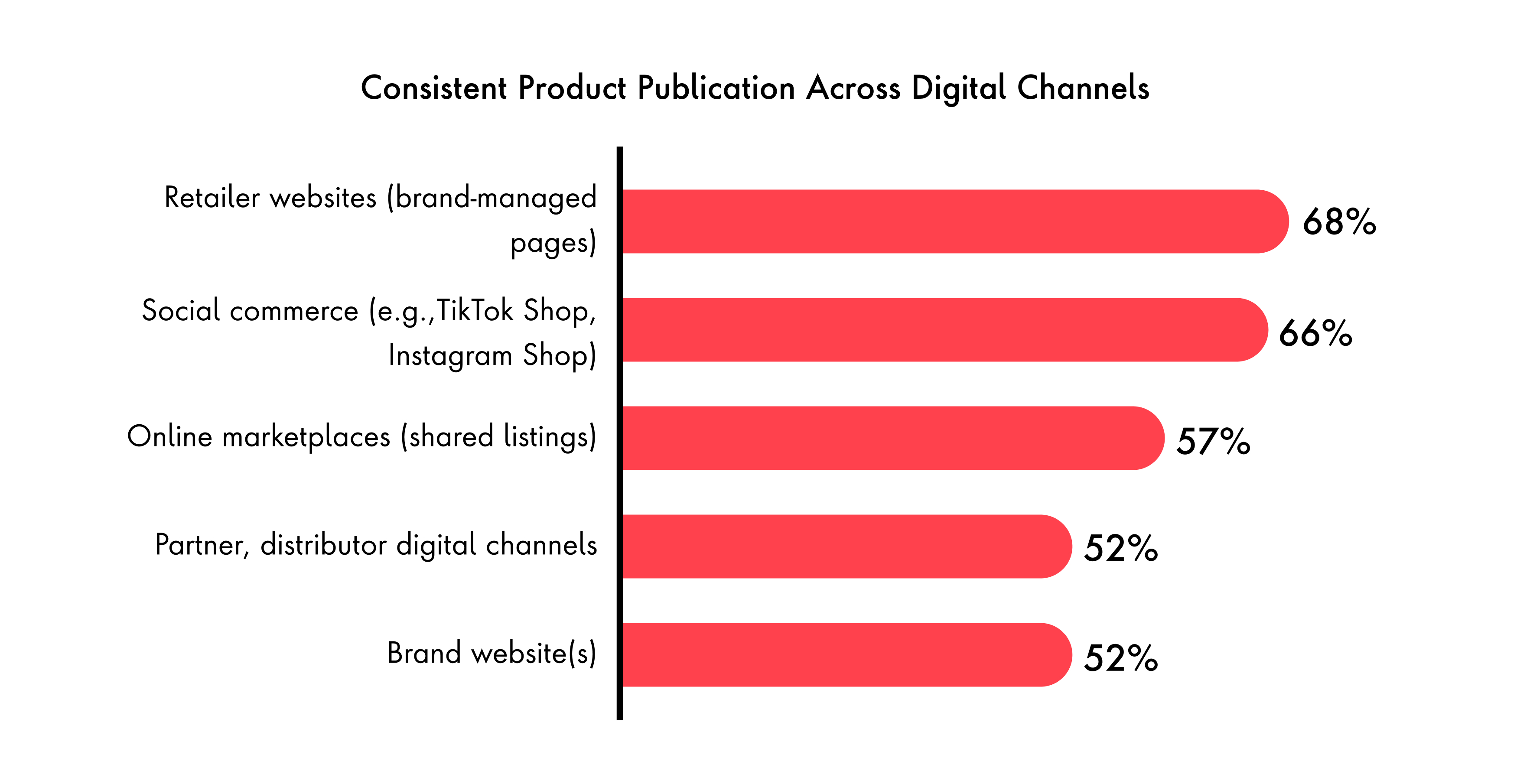
Publicis Sapient’s 2025 Guide to Next Consumer Products Research. Q. On which digital channels are your product information consistently published today? N=157 (CPG leaders).
Beyond visibility: the data dividend
The prize for machine-readable data goes beyond visibility. Agent-driven discovery gives brands better demand, lower costs to acquire customers and richer feedback. Imagine not just tracking what sold but knowing why an agent or AI tool recommended it (i.e., fragrance-free, certified sustainable or diet friendly). That intelligence powers the next level of personalization and product innovation.
For challenger brands, this may be the best opening in a generation, because research already shows that agents don’t favor history or scale but structured clarity.
Beware the new middlemen
But the fall of one gatekeeper risks the rise of another. Aggregators are already testing platform commerce agents that scrape brand data and insert themselves between consumer and product.
Agents already influence what shows up in social feeds, invisibly curating exposure to brands beyond paid ads, which is a preview of how algorithmic mediation is expanding from content to commerce. Without an AX strategy, companies may simply swap one middleman for another.
Flight booking is a cautionary tale: by the late 2000s, travel aggregators like Kayak and Skyscanner were pulling in millions of users a month by scraping airline sites. Airlines were then forced to pay hefty referral fees to reach customers they already had.
The same dynamic could hit consumer brands: either be invisible to commerce agents or pay margin-killing tolls to intermediaries. Avoiding this fate requires a different set of priorities than most leaders are tracking today.
As Merriott warns, “Retailers and marketplaces still dominate discoverability, but this is the moment to leapfrog them. Consumer products firms spend more on data and AI than retailers do.”
What leaders should know: The new rules of AX
Here are the concepts that matter now:
- AX isn’t SEO. Treating agent experience (AX) like a checklist is the fastest way to lose. It belongs in the boardroom because it affects the entire operating model. Product teams must design with codifiable proof points, like sustainability certifications, provenance and performance claims.
- Training data is the new media buy. The real fight is getting your facts and values into the sources AI agents draw from.
- Your brand isn’t a place, it’s a feed. Think of it as a stream of structured facts flowing into the machines that make choices for your customers.
- In the future, brands will be judged by their agents. Consumers may never see most of your ads or promotions. What they see is what their AI agent decides.
The takeaway
The shelf is no longer rented space in a retailer’s aisle but a contest of clarity, structure and trust. Done right, AX can be transformative: a challenger brand coding every claim to leapfrog incumbents or a luxury house proving not just that a bag is leather, but that it is ethically sourced and guaranteed.
As Simon James puts it, “This will be winner-takes-all in AI terms. Whoever becomes the default for ‘best detergent’ wins everything.”
Author: Kira Barrett
Research Lead: Alicia Trahan
Contributors: Simon James (International Lead, GVP, Data Science & AI), Helen Merriott (Consumer Products Industry Lead, EMEA & APAC), Erin Doyle (Director Customer Experience & Innovation Consulting, Delivery, Experience), Amin Rafinejad (Senior Client Partner, Sales & Leadership, Industry Sales)
The new era of in-car monetization
For the last 20 years, in-car monetization was mostly a punchline, good in theory but lackluster in practice. Underpowered onboard technology and clunky infotainment systems got in the way of innovation.
Now, the stakes are different. Consumers don’t buy cars every year like phones, and the average vehicle on American and European roads is over 12 years old. Margins are thin, regulations are tightening and new entrants are raising the bar. In this environment, in-car monetization isn’t a side bet. It may be the auto industry’s best bet for survival.
For automakers, the real opportunity begins after the car leaves the lot and becomes part of the driver’s everyday life. With every mile, the opportunity to deliver value for both automakers and drivers multiplies.
The software-defined vehicle has changed the game
Software-defined cars are dynamic and evolve with regular updates, like a smartphone. “After six months or a year, the same vehicle gives the driver a new experience because the manufacturer introduced a feature over the air,” explains Rajeev Singh, Publicis Sapient’s transportation and mobility lead for EMEA and APAC.
The industry is well on the way to seeing these kinds of updates as a revenue driver. According to Publicis Sapient’s 2025 Transportation & Mobility Research, only 34 percent of OEMs consider themselves to be mature in executing over-the-air updates, while the majority—58 percent—are still scaling [Figure 1].
Figure 1. Most automakers are scaling OTA capabilities—but true maturity remains rare
Nearly six in ten automakers (58 percent) are expanding beyond pilot phases, while only a third (34 percent) have made over-the-air updates and features upgrades a significant revenue contributor—signaling momentum but uneven execution toward fully monetized, software-driven models.
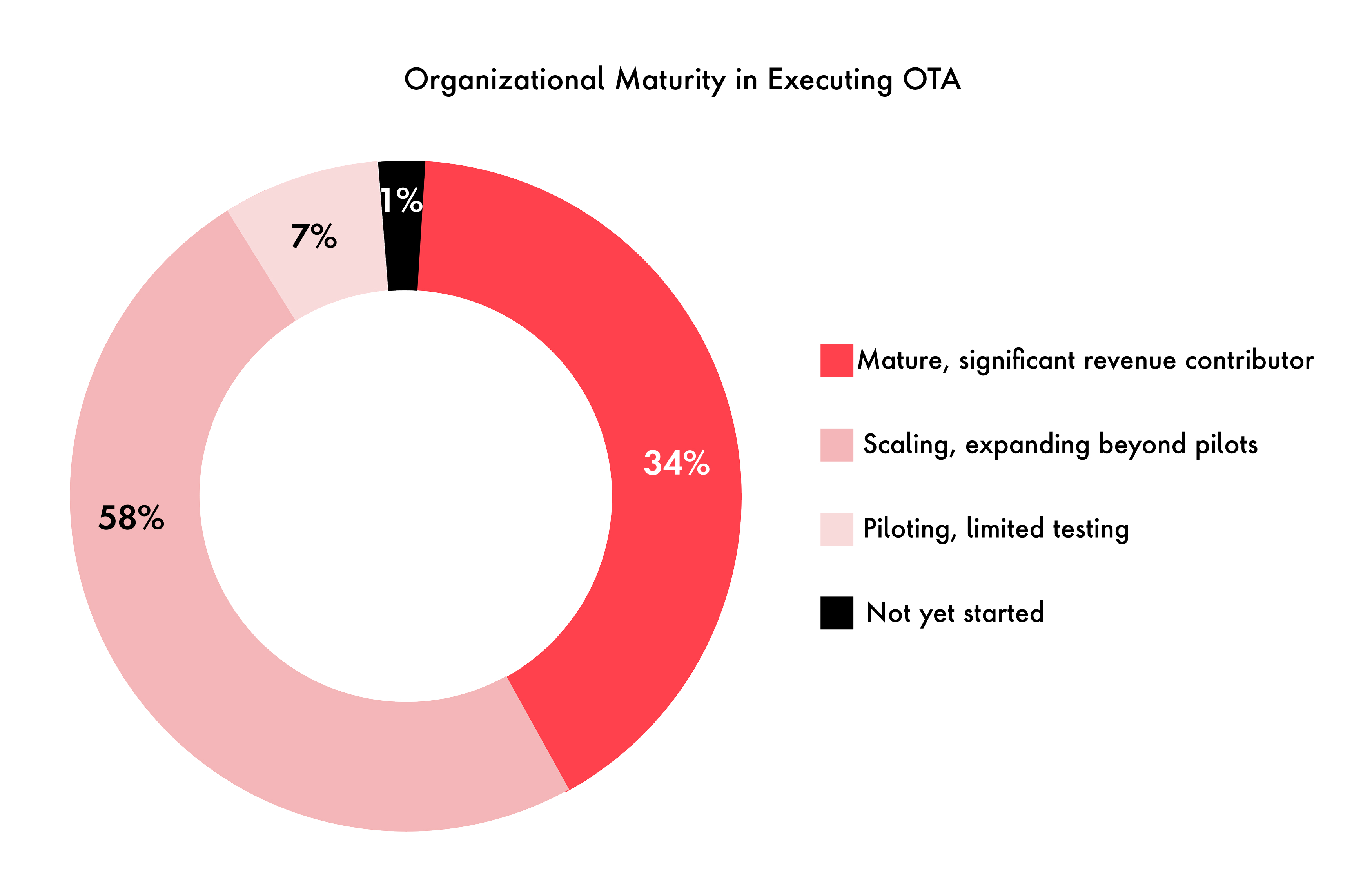
Publicis Sapient’s 2025 Guide to Next Transportation & Mobility Research. Q. At what stage is your organization in executing OTA updates, subscriptions, and feature upgrades? N=89 (Transportation & Mobility leaders).
Inspired by native-EV platforms like Tesla, Rivian or BYD that don’t have outdated tech baggage, legacy OEMs have added power and enhanced capabilities to their in-car technology, like oversized screens and smart controls to offer a safe and streamlined driving experience.
From car to concierge, thanks to agentic AI
In the not-so-distant future, agentic AI will act as an in-car concierge tailoring journeys to driver preferences, proactively scheduling maintenance appointments, booking a table at a restaurant along your route or reserving a spot at the next available charging station.
The automotive industry is ready to meet the moment, since 99 percent of surveyed industry leaders say they see agentic AI as essential to their monetization strategies. When paired with voice prompting technology and generative AI-powered speech recognition, agentic AI can turn your car into a fully interactive transactional hub, enriching the driving experience and paving the way for innovative monetization opportunities, such as targeted ads, voice commerce and as-needed upgrades.
This revitalizes life on board, says Jochen Funk, managing partner of automotive, DACH and strategy. “If you have a modern car with modern technology, especially AI, it changes the way you plan your trip and how you experience it.”
Autonomous vehicles will give drivers time for other tasks
Autonomous driving will only accelerate this transformation. According to AutoPacific’s 2025 research, 43 percent of consumers intending to purchase a new vehicle said they wanted a semi-autonomous driving feature in their car.
What does all this mean for monetization? Publicis Sapient’s 2025 Transportation & Mobility Research showed that 91 percent of industry leaders see autonomous driving as “extremely” or “very important” to their in-car monetization plans. After all, the possibilities are endless when we’re not glued to the wheel and have the technology to support better connectivity and “other utility-type services,” says Brian Clarey, vice president and managing partner. Built-in modems, hotspots and advanced cloud integration enable cars to support video streaming services, interactive gaming and the ability to make purchases while driving.
Cars become rich ecosystems for commerce, collaboration and connectivity through which you can push sales, offer bundled services and create unique customer experiences.
The bottom line: The tech to support in-car monetization is here. How can OEMs ensure it delivers real value to drivers?
Design for drivers, or your plans will never be profitable
Having the tech is only half the battle. The other half? “The human factor will be the big differentiator,” says Funk.
In-car monetization isn’t just a revenue play. Instead, the winners will be the OEMs who put customers at the center and design around the user, not just the balance sheet.
How can you do this?
- Get your data house in order. Data helps you determine your customers’ wants and needs, and many OEMs are currently learning how to collect this data fairly and responsibly. “Fairly” and “responsibly” are keywords, since 42 percent of automotive leaders cite regulatory or privacy concerns as barriers to scaling their in-car monetization plans. Data should be centralized so that sales teams—who directly work with customers—can better personalize the customer journey while sharing insights and feedback with product design and engineering teams.
- Design features people actually want. Drivers don’t always use new tech. A J.D. Power study found that drivers weren’t using one-third of new tech within three months of owning a new car.
“You need to make sure the feature you’re creating is useful and a market fit,” Clarey urges. “You’re going to improve your chances of success if you’re building the right things, packaging them correctly and commercializing them effectively.”
Your value-added services should address actual pain points. For example, drivers might find seamless, in-car payments valuable or want their car to display personalized, localized promotions, such as exclusive deals that pop up on their screen for a furniture retailer on the driver’s route. Specific, context-driven packages can offer temporary system upgrades as your customer needs them, such as weekend advanced driver-assistance systems (ADAS) tiers, entertainment packs for long road trips or off-roading performance bundles for camping trips.
What are some of the services leaders believe will bring the most value to customers? A majority (60 percent) of respondents see safety and maintenance bundles as a top service, while nearly half see connectivity packages (49 percent) and navigation/concierge services (47 percent) as other valuable services [Figure 2].
Figure 2. Safety and connectivity lead the in-car value race
Industry leaders see services related to safety and maintenance (60 percent), connectivity (49 percent) and navigation and concierge services (47 percent) as the most valuable to customers, far outpacing entertainment or payment innovations. This underscores that in-car monetization will succeed only when new services solve everyday driving pain points, not when they add novelty for its own sake.

Publicis Sapient’s 2025 Guide to Next Transportation & Mobility Research. Q. Which types of in-car services do you believe customers will find most valuable? N=89 (Transportation & Mobility leaders).
In-car monetization is still only on the horizon for a lot of OEMs: Publicis Sapient's 2025 Transportation & Mobility Research found that nearly half (47 percent) of leaders expect in-car monetization to become a revenue driver sometime between 2027 and 2030. In other words, don’t put off creating your strategies—the time to act is now.
It does not have to be difficult to implement. AI–especially generative AI and tools like Sapient Slingshot, which accelerates software development—makes implementation more manageable and intuitive.
With AI accelerators, implementation isn’t the challenge anymore. The real question is whether OEMs will be able to design for drivers. In-car monetization won’t fail for lack of technology. It will fail if customers don’t care.
Author: Parissa DJangi
Research Lead: Alicia Trahan
Contributors: Alyssa Altman (Consumer Products, Retail, Transportation & Mobility Industry Lead, NA), Rajeev Singh (Transportation & Mobility Industry Leader, EMEA & APAC), Jochen Funk (Managing Partner Sales & Leadership, Industry Sales), Brian Clarey (Managing Partner Sales & Leadership, Industry Sales)
Dear Publicis Sapient,
I’ve spent my career in the automotive industry and have seen it all—oil shocks, chip shortages, recessions. But I've never seen our supply chains under this much strain. We depend on a complex, global network to source the 50,000 parts needed to make a car, and a single blip can throw our fragile network into chaos. One rerouted shipment last quarter added three weeks and millions in costs to a single production line.
Now tariffs are adding another layer of uncertainty to an industry already on the edge... shifting from combustion to electric, navigating new regulations, keeping pace with new competitors and operating on margins that are already tight. I know our industry isn’t alone. Retail, luxury, financial services, even healthcare—all of us are reworking supply chains and pushing our profitability models to the limit.
Regionalization, workforce reskilling and policy dialogue all matter, but they may not be enough. So, I ask: what bold solutions are still missing from the conversation that could reset how this industry navigates the next decade?
Sincerely,
Veteran Automotive Leader
Response from Publicis Sapient
Dear Veteran Automotive Leader,
You aren't alone in your concerns. We've heard from leaders in many other industries who are grappling with some of the same challenges. And you're right: the auto industry's operating model wasn't built for this level of turbulence. Here are some things you can do to navigate it.
Incorporating AI and automation is now the backbone of resilience. For automotive, that could mean dual-sourcing critical chips even at higher cost, using digital control towers for real-time visibility, designing modular vehicle components or creating reskilling platforms that keep pace with new technology. None are simple, but each shifts the model from fragile efficiency to durable adaptability.
Next, clear the clutter from your data. Build an AI “control tower” that acts like a product manager by flagging parts at risk, predicting shipment delays and surfacing trends that actually matter. Start with one plant or one lane, then scale. Each step builds further resilience.
Now let’s talk customers. They'll hesitate to purchase when tariffs push prices higher. Counter that with digital experience products that anticipate demand: AI-driven financing tools, personalized offers and proactive service alerts. The goal is to make every interaction so seamless that hesitation gives way to confidence.
Don’t forget that your supply chain should operate like a living product. Equip it with real-time visibility dashboards, predictive forecasting and dynamic sourcing models that can shift vendors in days, not months. Review and refine those plays the way you’d update a product release.
Finally, shake off the fear of trying something new. AI carries risks, but standing still is riskier. At Publicis Sapient, we’ve shifted from relying on rigid processes to building AI products like Bodhi and Sapient Slingshot that anticipate and adapt to it.
These tools learn, adapt and get better the more they’re used. In a world defined by volatility, resilience comes from systems that keep improving over time.
Tariffs may be today’s headline, but tomorrow it will be something else. The leaders who thrive won’t just survive the shocks; they’ll redefine their industries by building product-driven systems that adapt, improve and compound value over time.
Let's transform this talk into action,
Publicis Sapient
The delays that hurt patients most
Rachel goes to the doctor for a follow-up on a recurring condition. The visit itself takes 15 minutes. What drags on for weeks is everything else: eligibility checks, prior authorizations, billing corrections. For Rachel, that’s stress and uncertainty. For her provider, it’s lost time and delayed revenue. For her health plan, it’s administrative drag that drives up cost.
Despite the hype around AI diagnosing or replacing clinicians, the real frontier for transformation is much less glamorous—and far more urgent. It’s the care access infrastructure: eligibility, claims, scheduling and enrollment. These “invisible” processes determine whether care starts on time or stalls in limbo. Right now, they’re failing both patients and the organizations who serve them.
The AI opportunity is access
Healthcare news headlines still focus on AI’s flashiest use cases—algorithms reading scans, robots in surgery and digital assistants documenting visits. But these innovations don’t solve the bottlenecks patients are feeling.
The most immediate patient frustrations are administrative: weeks-long waits for coverage confirmation, surprise bills arriving months after treatment, prescriptions delayed by authorization snags or endless loops with payer hotlines.
In 2026, here’s where AI can make the biggest, fastest difference:
- Navigation and scheduling (triage included)
AI can guide patients to the right care setting, forecast no-shows, reprioritize waitlists, backfill cancellations in real time and even triage cases based on urgency.
What the patient feels: faster appointments, fewer dead ends, more confidence they’re in the right place. A parent no longer waits days for a specialist referral; an urgent symptom triggers immediate prioritization.
- Billing and affordability
AI can confirm coverage instantly, adjudicate claims at the point of care, flag financial assistance programs and help patients see costs up front.
What the patient feels: no surprise bills, less financial anxiety, trust that the system is transparent. A patient can see the cost of a procedure before it happens, eliminating weeks of uncertainty and phone tag.
- Medication and continuity
AI can check formularies, recommend therapeutic alternatives, flag assistance programs and refill prescriptions automatically when clinically appropriate.
What the patient feels: fewer treatment gaps, easier refills, more consistent care. A chronic pain patient doesn’t run out of medication midweek, and care plans are coordinated across providers automatically.
These aren’t speculative ideas; they’re reality. Omega Healthcare reported saving 6,700 staff hours a month and generating a 30 percent ROI through AI automation. A 2025 Waystar/Qualtrics survey found that 92 percent of revenue cycle leaders now prioritize AI in claims, billing and patient access.
“There is opportunity for AI here that is clearer and more immediate. Just as Amazon redefined retail with one-click ordering and banks transformed consumer trust with real-time fraud alerts, healthcare must modernize its system-level interactions,” Tim Lawless, senior vice president and health lead says.
“Agentic AI enables precisely this: not just better answers, but better actions that move patients through the system faster, reduce administrative waste and support overburdened staff.”
Scaling AI takes more than tech
The economics of modernization have shifted. What once required a five-year, $30 million replatforming can now be done in less than 18 months for less than $10 million with AI-enabled systems. But speed and cost savings aren’t enough.
For AI to scale in healthcare, adoption must be both emotional and technical. On the technical side, organizations must tackle governance, equity and workforce challenges. On the emotional side, patients, clinicians and executives must believe in the value of AI:
- Belief: Patients must believe AI is working for them, not surveilling them. Clinicians must believe automation lightens their load, not adds bureaucracy. Executives must believe ROI is durable, not another pilot destined for the shelf.
- Governance: AI must be explainable, auditable and compliant, particularly in high-stakes processes like enrollment and billing.
- Equity: Models need to be trained on diverse data to avoid widening disparities in access or affordability.
- Workforce: Roles will shift from manual processing to orchestration and oversight. Leaders should frame this as an opportunity for new careers in AI orchestration and outcome design, rather than displacement.
AI platforms provide seamless, scalable, human care
By 2026, the impact of AI will be most visible in how it reshapes patient access and operational capacity. And critically, adoption won’t be confined to isolated pilots—it’s spreading across the healthcare ecosystem:
- Providers are deploying AI to address capacity challenges, streamline scheduling and ensure patients enter the right care pathway. For health systems strained by workforce shortages, the ability to reduce waste and maximize throughput is transformative.
- Payers are using AI to enhance member engagement, simplify benefit navigation and support smarter care decisions. This reduces friction for members, improves satisfaction and lowers unnecessary utilization.
- Life science companies are embedding AI into patient support programs, education platforms and adherence services. Rather than relying solely on call centers, they’re orchestrating timely, personalized interactions through AI-driven agents.
The key shift is breadth. AI is becoming the connective tissue of a more responsive healthcare system. Looking further ahead, healthcare could feel fundamentally different:
- Seamless navigation: Patients describe symptoms once and are guided to the right setting, schedule and followed up automatically.
- Optimized capacity: Provider calendars flex dynamically so urgent cases are prioritized, cancellations are instantly backfilled and no slot is wasted.
- Fluid connections: Providers, payers and life sciences organizations operate on shared AI-driven platforms, orchestrating patient journeys across silos.
- Pilots to platforms: AI moving from isolated experiments to foundational infrastructure.
In that future, AI doesn’t replace doctors or nurses. It becomes healthcare’s invisible infrastructure, eliminating administrative waste, amplifying human impact and restoring trust. From eligibility to refill, triage to billing, AI quietly works behind the scenes, letting humans focus on what they do best: caring for patients.
Author: Alex Bova
Contributors: Tim Lawless (Health Industry Lead, NA), Russell Van Gorp (Managing Director of Health Strategy)
Volatility demands faster calls
Picture this: A geopolitical crisis suddenly erupts, sending shockwaves through global oil supply chains. At the same time, an unexpected surge in demand strains energy reserves. You need to make quick decisions that have an impact across your value chain.
This is likely what’s in store for 2026. The demand for utilities is expected to jump 25 percent by 2030, while uncertainty surrounding oil production and demand persists. At the same time, the rise of power-hungry data centers, volatile oil prices, renewables integration and ongoing supply chain disruptions in an unpredictable geopolitical environment will cause even more turbulence.
Your edge in 2026 won’t be the power of your tech, but the speed of your decisions. To make these kinds of decisions, you need to improve how all parts of your business work together by cutting across functional silos.
AI-powered value chain optimization (VCO)—a holistic process that fine-tunes every part of the value chain and breaks down the silos that sabotage them—does just that by aligning different units and functions to the shared goal of company profitability. It makes it easier for you to stay light on your feet and make fast decisions at the speed of markets.
Silos are holding companies back
Many leaders think they need better silos. In fact, silos are the problem. In the energy industry, businesses are often siloed into oil production, manufacturing and sales; for Power & Utilities, it’s generating power and delivering it to customers. These silos come with their own teams and geographies, creating a tangled web of redundant organizational charts.
The issue is that these silos make it difficult to make timely decisions. For example, trading desks and wind farms aren’t always connected, and this can lead to missed opportunities. The trading desk might know how to make the best returns, but if this information doesn’t reach the people planning new wind farms, important decisions are made without the full picture. This gap results in potentially lost profits.
That’s not just a theory. According to Publicis Sapient & AWS 2025 Energy Research, 79 percent of energy leaders expect better data quality and reliability from integration efforts, 67 percent expect greater agility and 52 percent expect cost savings. Breaking silos isn’t a nice-to-have; it’s the path to resilience.
VCO supercharges your ability to make decisions
Phillips 66 learned the value of connecting its value chain by rolling out a VCO solution that cut across functional silos, slashed wasteful spending and built substantial savings. The result? The company saved millions.
VCO is like the central nervous system in a body. Individual organs—departments like operations or IT—are vital, but without the nervous system coordinating them, the body can’t function properly.
VCO is all about getting the most profit across all parts of your business rather than just cutting costs in individual departments. When all functions work together toward the shared goal of profitability, the results are more impactful than when each department goes it alone. To make it work, you need three things: clear data sharing, updated decision criteria that focus on the whole company’s goals and a structure that gives people the authority to make decisions across functions.
VCO unifies operations, but AI future-proofs and accelerates it. By crunching vast sets of data, AI helps you keep up with the fast-paced markets so that you can make the decisions today and tomorrow.
AI ups the ante on VCO
Most AI projects fail. MIT’s Networked AI Agents in Decentralized Architecture (NANDA) claimed that 95 percent of AI initiatives haven’t created any value. This is happening because businesses are stuck in proof-of-concept purgatory and struggle to scale AI.
Solutions like Sapient Slingshot, our software development accelerator, can help, as can tools like generative AI, which can pull from shared data pools to generate quick insights. AI can provide a real breakthrough in implementing VCO. But AI's value isn’t in building—it’s in deciding.
AI’s real superpower is its ability to turn raw data into insights you can act on. Typically, linear programs and machine learning crunch numbers to help you make informed decisions. Generative AI can speed up this process by summarizing the important takeaways. By analyzing contracts to summarize them, identify hidden opportunities or prioritize information, for example, it ingests critical data and gives outputs that cut through the noise, making it easier for you to act.
Take an energy supply and trading firm, for instance. “The quicker you’re able to get data from your wind farm over to your trading desk to then make a decision on what to do with it, and then communicate that back to the wind farm is what’s going to differentiate you from competitors,” explains Andrew McMillan, senior product manager.
If the weather is favorable, the wind farm might produce excess electricity. An AI system predicts an output surge; this data instantly goes to the company’s trading desk, where AI analyzes current electricity market prices. Seeing that prices are high, the trading desk decides to sell the anticipated excess power on the spot.
That’s just one example. AI-powered decisions across the value chain enables you to adjust refinery configurations to produce more profitable products based on real-time market prices. Alternatively, you can make pre-investment decisions for large projects or decide when to schedule asset maintenance based on the weather.
You can start optimizing your supply chain today
Here’s what leaders should do now:
- Audit and upgrade your data infrastructure: Poor data management is costly, making organizations flush $12.9 million down the drain. Ensure that your energy production and consumption data is accurate, timely, granular and easily accessible in shared dashboards visible to every team.
- Break functional silos with integrated dashboards and teams: This involves connecting data from distributed assets with IT systems for real-time analysis, fundamentally shifting organizational structures to make the whole system run smoothly.
- Modernize energy supply and trading for agile decision-making: Don’t let outdated trading systems slow you down. Use AI to modernize your systems, turning them into a real-time intelligence hub that helps you make faster, smarter trading decisions.
- Put people at the center of your transformation: Train your talent through upskilling programs and opportunities. Start small with AI projects focused on areas like predictive maintenance or demand forecasting to demonstrate their value.
By 2026, the companies that win won’t be the ones that own the most assets or the smartest AI. They’ll be the ones that decide first—and decide right.
Author: Parissa DJangi
Contributors: Alok Lakhchaura (GVP Technology, Delivery, Engineering), Masud Haq (Senior Vice President, Sales & Leadership, Industry Sales), Boris Leshchinskiy (Associate Managing, Director, Delivery, Strategy), Andrew McMillan (Senior Product Manager, Delivery, Product), Sidd Venkatesan (Senior Client Partner, Sales & Leadership, Industry Sales)
Why the old growth logic no longer works
Telcos and media companies are at a crossroads. With fewer subscribers, more ways of consuming content and new opportunities, the ways in which audiences connect, and what they expect from you have fundamentally shifted. That’s more than a distribution problem; it’s a business model crisis. The old growth logic of focusing on just subscriber adds and impressions no longer works.
Your audience hasn't disappeared—they’ve stopped waiting for you. To win in 2026, you must compete in an algorithmic arena where trust and AI decide visibility.
Today’s audiences are elusive
TMT can’t take its subscribers and customers for granted. As an October 1, 2025, MoffetNathanson report pointed out, a demographic shift in the United States—fueled in part by new immigration policies and emigration patterns that could contribute to net-negative migration in 2025—means that telcos are fighting over a shallow customer pool that grows more stagnant by the year.
Meanwhile, media and sports aren’t just losing audiences to competitors—they’re losing them to platforms that were never in the media business at all. Both industries are seeing more fragmentation, as customers and fans seek content on a seemingly endless catalog of new platforms, such as TikTok, Instagram Reels and immersive gaming ecosystems such as Fortnite, which has 110 million active users every month. The captive viewer is gone; audiences are everywhere and nowhere at once.
So, how can you follow, find and monetize your customers when they keep shifting?
The new playbook is all about data and AI
What new strategies will position you well for 2026 and beyond? Data and AI can arm you with the insights you need to make the most of the audiences that you have.
Flat growth makes ARPU all the more urgent for telcos
Today’s telcos face a sobering reality: Everyone has a phone with a long shelf life. How can telcos grow? Expanding your market share is not enough. Instead, drive up the average revenue per user (ARPU) through value-added services, such as gaming or streaming packages, to get more value from your customers. The market for these services could exceed $530 billion by 2030, up from $223 billion in 2024. Publicis Sapient’s 2025 Telecommunications & Media Research found that 18 percent of telcos are leaning toward or focusing exclusively on ARPU growth and only 14 percent are focused purely on net adds—the beginnings of a tectonic shift in how telcos are strategizing for future growth. The imperative is clear: Lead the wave or get left behind [Figure 1].
Figure 1. The growth equation has flipped
Subscriber-led expansion is giving way to ARPU-driven strategies—telcos are redefining growth around value, not volume.
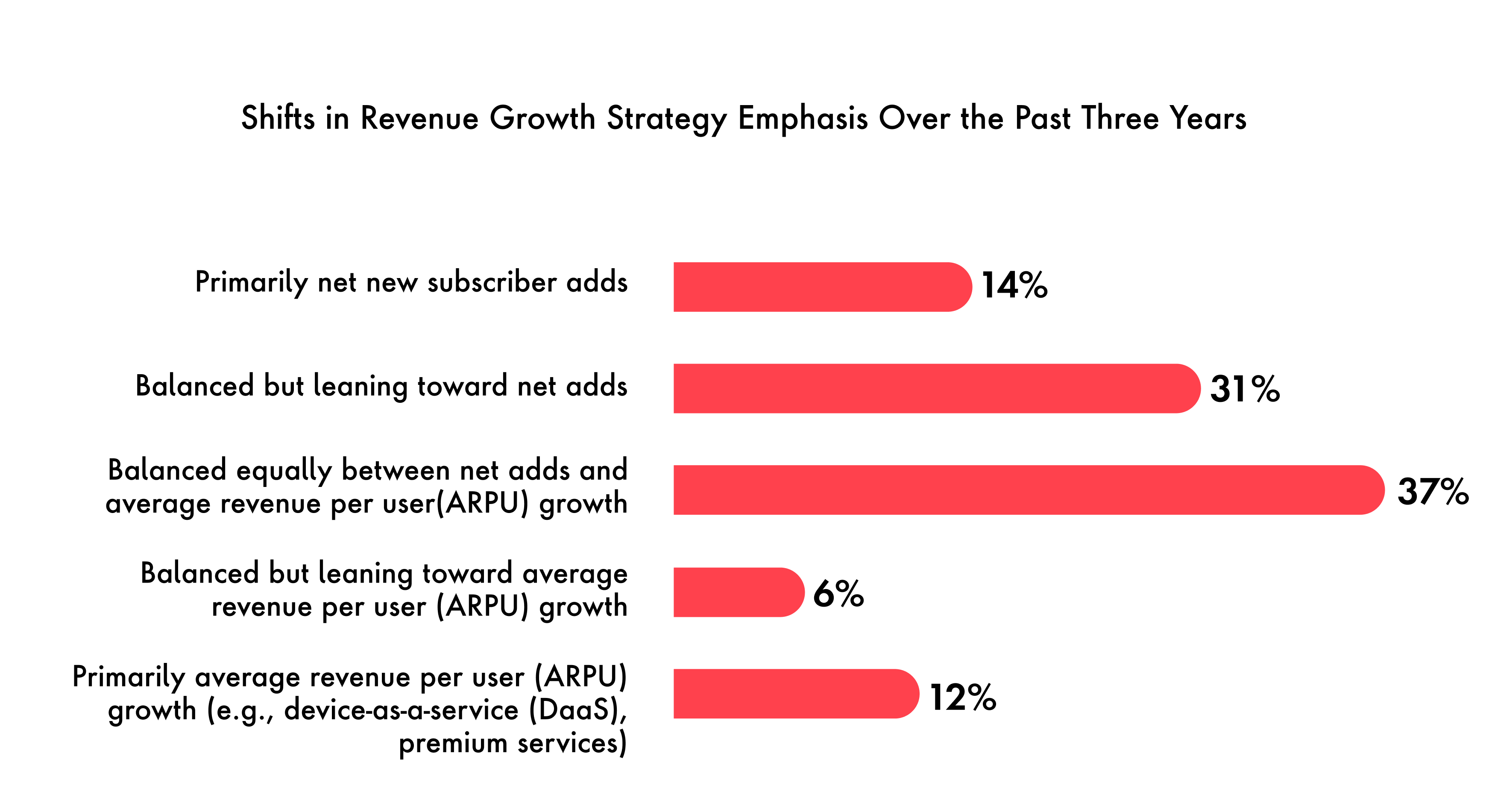
Publicis Sapient’s 2025 Guide to Next Telecommunications Research Q. Over the past three years, how has your revenue growth strategy shifted in emphasis? N=86 (Telecommunications leaders).
Want consent to use data? Build trust
Telcos and media are drowning in data. The real challenge is getting the right to use data—and that’s a trust issue. Insights from our 2025 commerce experience research found that 80 percent of respondents in France, Germany, the United Kingdom and the U.S. were concerned about companies using their data. That means they may be less inclined to share it, a reality that would leave you with fewer insights. Publicis Sapient’s 2025 Telecommunications & Media Research found that executives mirror these concerns, with 52 percent of execs in media and 48 percent in telco cite regulatory and privacy risk as their top barrier to adopting AI more broadly.
This trust deficit could have an echo effect, since you need the right kind of data to better serve your customers and create new services for them. Indeed, many telcos are already facing this challenge, since 61 percent of telcos leaders believe data debt is “extremely” or “very” impactful in delaying or blocking customer experience innovation.
How can TMT incentivize customer consent? Progressive consent embeds privacy consent into the digital experience. “If you build the right compelling user experience, people will give you the right to use the data. They just need to understand the value proposition,” says Ray Velez, CTO of customer data solutions.
That means communicating a clear value exchange by giving customers access to exclusive content, discounts or other incentives, such as a beauty retailer giving customers access to an AR try-on feature. Publicis Sapient’s 2025 Telecommunications & Media Research shows that 92 percent of media leaders expect progressive consent to have a moderate to significant impact on trust and dating sharing [Figure 2].
Figure 2. Progressive consent becomes a catalyst for trust
Most media and advertising leaders believe embedded consent mechanisms will strengthen relationships given the vast majority (92 percent) expect moderate to significant business impact on customer trust and data sharing within three years, signaling privacy is evolving from compliance to competitive advantage.

Publicis Sapient’s 2025 Guide to Next Media Research. Q. What level of business impact do you expect progressive consent mechanisms (embedded into the user experience) will have on customer trust and data sharing in the next three years? N=91 (Media & Advertising leaders).
Personalization is the new gold standard
Telcos and media companies have long struggled with true personalization. Simply offering five different plans or the same five commercials isn’t personalization. You need to tailor offers, products, services and relevant ads to the individual customer.
AI is here to help. “Targeting individuals and hyper-personalization was not possible to the same level without having this AI that we’re now witnessing,” says Vlad Panov, vice president of engineering for Innovation Hub.
As telcos reconsider their strategies in the AI era, media networks—which some abandoned after early setbacks in the early 2010s—are ripe for renewed exploration. This evolution is crucial as these networks move from the traditional world of linear advertising to a more dynamic, data-driven model that will help telcos and media companies alike redefine their approach to audience engagement and revenue generation.
Media networks apply what Velez calls the “web’s best personalization model” to engage customers and increase revenue. Though retailers have led the way in adopting media networks—Walmart’s network is responsible for 12 percent of all the company’s profits—both telco and media companies can stand to benefit too. Publicis Sapient’s 2025 Telecommunications & Media Research shows businesses employing media networks are seeing results, with nearly four out of five (79 percent) media executives seeing “high” or “moderate” ROI.
How can you ensure a high ROI? Media networks are most impactful when they’re relevant, such as ads for charging cables on a phone bill or noise-canceling headphones for customers streaming content from an airport. This approach leads to better engagement and satisfaction because customers see them as helpful rather than intrusive.
You need clean data to build a successful media network, and by launching your own cleanroom—something that NBCU, Disney and Warner Brothers Discovery have already done—you can allow advertisers to collaborate securely with your media network. This collaboration closes a long-standing gap: the inability to link media spend to real commercial outcomes. Instead of measuring campaigns against impressions, reach or click-throughs, cleanrooms make it possible to tie ad exposure directly to transactions and adjust your campaigns in real-time.
Media’s next monetization test is the changing ad landscape
Advertising has been at the heart of the media landscape, with 72.4 percent of all TV viewing coming from platforms with ads. But here’s the rub: Viewers are often served up ads that are irrelevant. A recent survey from Tubi found that 63 percent of respondents cited “irrelevant ads” as a point of frustration.
Agentic AI will automate this process by connecting audiences to the right ads. “Agentic AI is the next generation of programmatic advertising” and will be “more sophisticated” by reducing human error, says Steve Ehrlich, vice president of business development.
Conversational ads and shoppable ads, powered by AI, are also on the rise, blending tech with human interaction to personalize experiences and help customers find what they’re looking for in new ways. And media executives have high hopes for them—according to Publicis Sapient’s 2025 Telecommunications & Media Research, 81 percent are seeing “high” or “moderate” ROI from shoppable ads, and 74 percent are seeing the same from conversational ads [Figure 3].
Figure 3. ROI of ad models remains uneven
Most media companies see strong ROI from contextual (80 percent) and shoppable ads (81 percent), while conversational ads lag with lower returns and higher risk. This confirms that in a fragmented audience landscape, media players must prioritize proven formats for revenue while carefully testing emerging ones, with AI as the differentiator for consistency in the future.
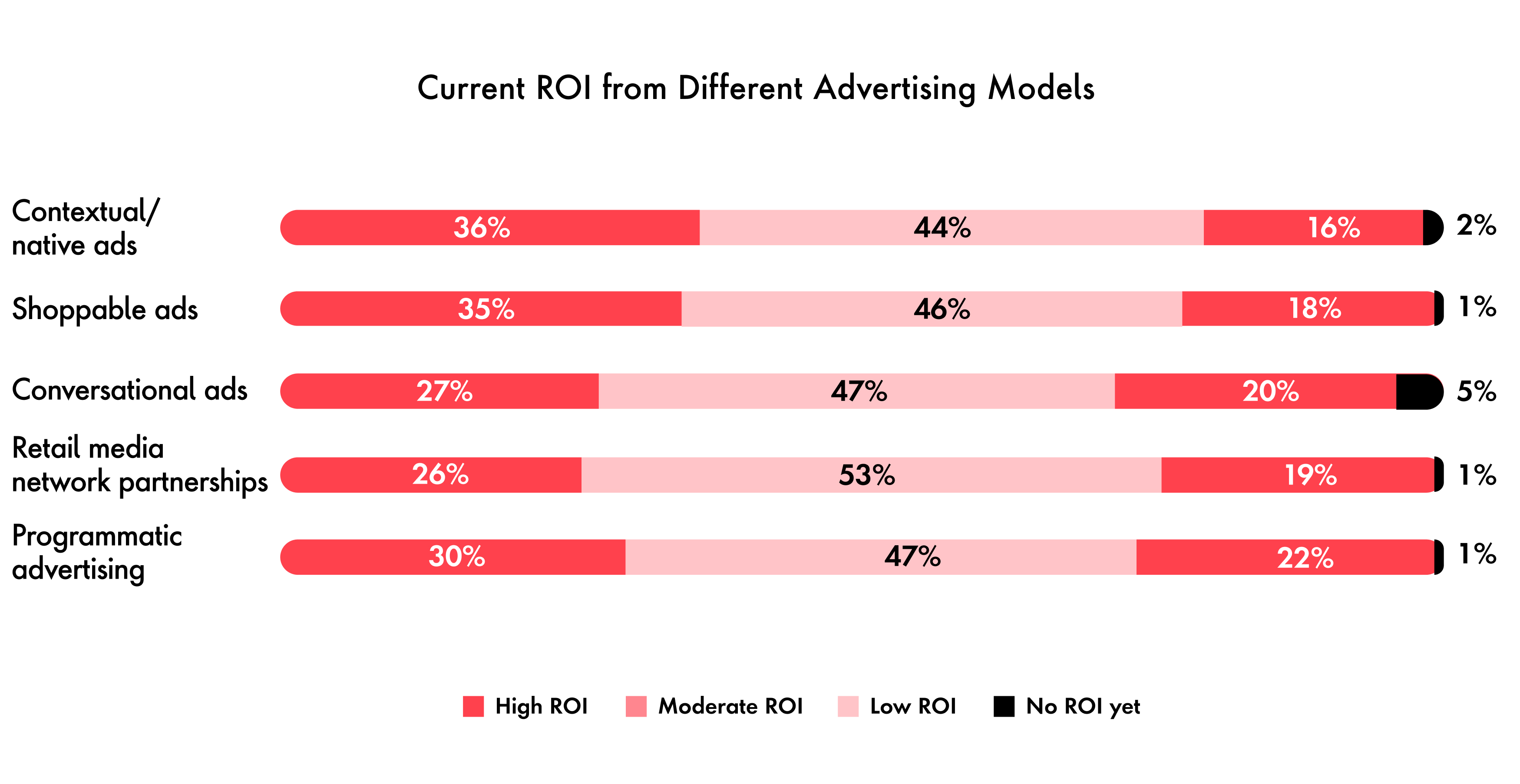
Publicis Sapient’s 2025 Guide to Next Media Research. Q. What ROI do you see today from each of the following ad models? N=91 (Media & Advertising leaders).
Evolution is existential
The pace of change for telcos and media isn’t slowing down—it’s only accelerating. The message couldn’t be clearer: TMT needs to embrace new strategies or risk becoming relics. Data and AI aren’t just tools but lifelines. Adapt swiftly, innovate audaciously and reimagine relentlessly because playing it safe is the riskiest move of all.
Author: Parissa DJangi
Research Lead: Alicia Trahan
Contributors: Raj Shah (Telco, Media & Tech Industry Lead, NA), Raymond Velez (EVP & Chief Technology Officer for Customer Data Solutions), Steve Ehrlich (VP Business Development Sales & Leadership, Industry Sales), Vlad Panov (VP Engineering Delivery, Engineering), Rizwan Devji (Senior Account Director Sales & Leadership, Industry Sales)
Who controls travel in 2026?
Travel distribution has always felt like an exclusive party. Hotels, airlines and online travel agencies (OTAs) took turns playing host, deciding who got past the velvet rope of inventory and loyalty programs.
But 2026 is shaping up differently. The velvet rope is fraying, new rooms are being added to the club and uninvited guests, armed with new technologies and cultural clout, are already inside.
The conversation is too small
For years, the industry has obsessed over a narrow distribution battle: OTAs versus direct bookings versus the remnants of Global Distribution Systems (GDS). OTAs and GDSs are still growing, but their growth rates are slowing. Direct hotel bookings are projected to outpace OTA bookings by 2030, and yet, the GDS market itself is expected to double by 2031.
At the same time, younger travelers are shifting to to TikTok, AI channels and portable digital identities.
In the future, distribution will no longer be just about your OTA vs GDS. It is about your control of attention, trust and the data that shapes traveler interactions everywhere.
AI as a new channel
AI opens new paths for travel direct distribution, from verified brand data feeds to attribute-level pricing that lets travelers build stays feature by feature.
Agentic commerce
Travelers are starting to trust AI platforms not just for inspiration but for price comparisons and booking. Today, most of these tools still rely on OTA data, but the Model Context Protocol (MCP) gives hotels and airlines a way to supply verified content directly. In practice, it’s a way to teach AI assistants your official data instead of letting them scrape it elsewhere.
Adoption won’t happen overnight, but brands can begin by piloting MCP in a few markets and working with partners who understand how to format the data.
Attribute-level pricing
Travelers increasingly want to build their stay piece by piece, choosing the view, breakfast or activities that matter most. OTAs already excel at merchandising these add-ons, while many brands still sell fixed packages.
To compete, hotels need to break out individual features and make that information machine-readable so AI assistants can surface them in search.
Influencers are the new gatekeepers
A creator livestreams from a Kyoto ryokan, and viewers book the same room in real time. The line between inspiration and transaction disappears.
This shift to influencers is already visible in retail, and travel is beginning to follow. According to Expedia’s 2025 Traveler Value Index, more than 70 percent of travelers have booked a trip based on an influencer’s recommendation. Platforms such as YouTube and TikTok are adding booking features that allow creators to handle the entire journey from idea to purchase. The next large-scale distributor of travel could be a creator collective, a lifestyle platform or an AI tool that connects everything together.
For travel brands, influencers should be seen as distribution partners, not just a source of awareness. The opportunity is to work with creators on campaigns that let travelers’ book directly from the content they are already watching.
Experience marketplaces and lifestyle bundles
The next travel disruptors could be wellness apps or music festivals, packaging flights, hotels and experiences in one seamless bundle.
This experience marketplace approach is already gaining traction. The global super-app market is projected to reach $918 billion by 2033, and, in Singapore, more than half of consumers use super-apps every week. A super-app for travel could combine services such as payments, shopping, messaging and excursions, creating a one-stop shop for vacations and daily life.
While these decentralized marketplaces won't replace OTAs, they will draw valuable customers by embedding travel into lifestyle ecosystems. Right now, only 14 percent of travel brands currently meet Gen Z’s digital expectations. For brands, the opportunity is to experiment with experiential partnerships that bundle travel in ways customers already value.
Identity without intermediaries
Today, hotels, OTAs and airlines hold all traveler data. Self-Sovereign Identity (SSI) flips that model, giving travelers portable “loyalty wallets” that brands connect to rather than store themselves. A guest could arrive at any hotel or airline and be recognized instantly, with preferences and status intact.
This shift is already underway. India’s DigiYatra has already handled more than 60 million journeys, while the EU Digital Identity Wallet will launch across borders in 2027.
Brands will still collect their own guest data, but these efforts often fall short and provide only a narrow perspective. SSI expands the view by enabling instant, verified insights from beyond a brand’s own ecosystem. Imagine a passenger arriving at your counter with gold status at a rival airline and verified in real time through SSI. How would you treat that passenger differently?
The balance of power is slowly moving from corporations to individuals, forcing brands to rethink loyalty. Yet only 15 percent of travel companies can currently segment effectively across paid and owned channels.
The opportunity for brands is to join early pilots and design loyalty models that thrive in a decentralized environment.
Risks in a decentralized future
As with anything, sometimes too much choice isn’t a good thing—and the new decentralization party will not be simple. Too much distribution fragmentation will overwhelm travelers—how do they know what’s best if every influencer, micro-marketplace and AI platform becomes a booking gate? Trust will also be an important and elusive KPI to measure.
Global adoption of certain technologies (SSI) will also likely fracture along regulatory lines, with MENA and India piloting bolder models while Europe and the United States wrestle with privacy and compliance.
The first to the dance floor
However, every system has a moment where the rules flip overnight. For travel and hospitality, the only question is when.
It could be an influencer marketplace suddenly rivaling an OTA in volume, a government mandate that forces digital identity standards or a hotel chain bold enough to integrate directly into AI assistants. Then the floodgates break open, and everyone else is pressured to catch up.
The last decade’s fight was over distribution control: OTAs, GDS, brand.com. The next decade’s fight is about cultural and algorithmic control: who captures attention, who carries identity and who the AI concierges “choose” to show.
The real question for travel leaders is who will be first in adapting, setting the path for everyone else.
Author: Kira Barrett
Contributors: Nick Shay (Head of Travel & Hospitality, International), Jagdish Ganshani (SVP & Managing Partner, Travel & Hospitality), Teaque Lenahan (Managing Partner & Group VP, Travel & Hospitality), Arjun Dutta (Senior Client Partner, Travel & Hospitality), J F Grossen (Global VP of Customer Experience), Mukhundan Sundaram (Senior Director, Technology, Delivery, Engineering), Bragadish Natarajan (Senior Director, Product Management, Delivery, Product), Shiladitya Ghosh (Senior Director, Client Executive, Travel & Hospitality), RJ Jain (Senior Product Manager, Delivery, Product), Kaushik Srivatsan (Associate, Product Management L1, Delivery, Product)
Methods & More
The details, downloads and discussions

Join Our Experts Live on LinkedIn
Dive a little deeper into the issues shaping 2026, as our experts dissect some of the trends, challenges and opportunities that will define the year—exclusively on LinkedIn.
Research Methodology
This report is based on internal qualitative interviews and a quantitative survey conducted by IPSOS in September 2025, spanning five industries: Consumer Products, Retail, Transportation & Mobility, Telecommunications and Media. The study captured insights from nearly 70 Publicis Sapient strategy, product, engineering, customer experience, data and AI experts who participated in 30-minute in-depth interviews and 540 senior decision-makers in digital transformation across seven markets: the United States, United Kingdom, Germany, France, China, Australia and Italy. Markets were selected for their leadership in shaping global industry standards and innovation.
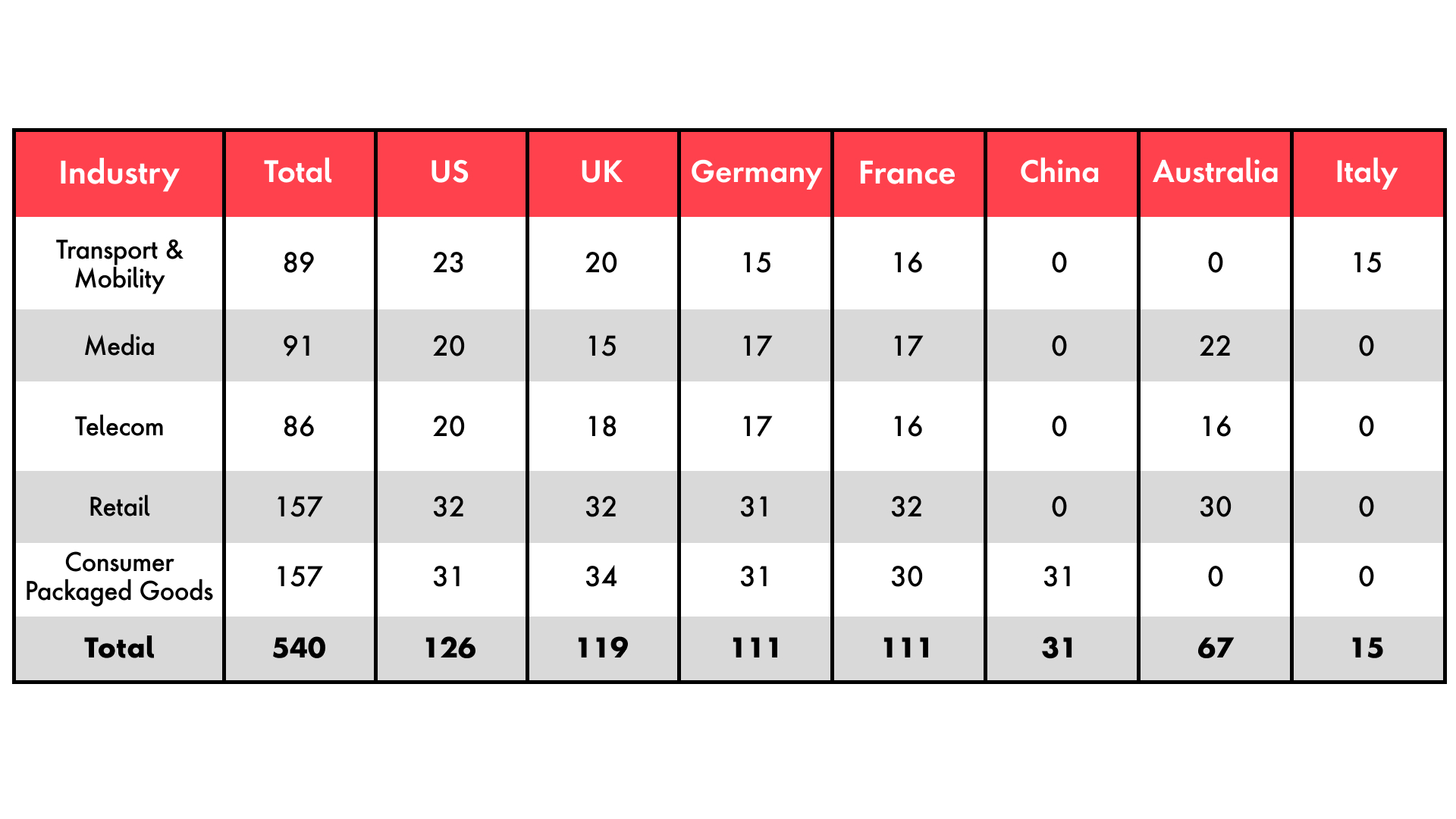
Respondents were C-Suite leaders or direct reports with recognized expertise and decision-making authority. They represented functions including executive leadership, IT, marketing, customer experience, operations, procurement and supply chain, strategy and transformation (including AI), finance, innovation and R&D, data and analytics and engineering. Eligibility required a senior management role (minimum one year in position) at organizations with revenues of $1B+ and workforces of 1,000+. All participants had direct responsibility for, or influence over, selecting external consultants and service providers for digital transformation.
Fieldwork was conducted via secure, self-completed online surveys in local languages, adhering to market research guidelines, confidentiality and data protection standards. Results were analyzed at industry and total levels, with significance testing at the 95 percent confidence interval to identify meaningful differences.
Special thanks to: Abhishek Kumar (Senior Director, Data Science), Alok Lakhchaura (GVP, Technology), Amin Rafinejad (Senior Client Partner), Andre Pierre-Engberts (VP, Technology), Andy McMillan (Senior Product Manager), Anne Phelan (VP Product Management, International Product Lead Retail & Consumer Products, EMEA Product Management Lead), Arjun Dutta (Senior Client Partner, Travel & Hospitality), Ashish Bhadauria (Senior Principal, Strategy & Management Consulting), Audrey Zong (Senior Principal), Alyssa Altman (Consumer Products, Retail, Transportation & Mobility Industry Lead, NA) Boris Leshchinskiy (Associate Managing Director), Bragadish Natarajan (Senior Director, Product Management), Brian Clarey (VP, Managing Partner), Courtney Trudeau (Managing Director, Delivery & Strategy), Dan Pitchenik (Financial Services Industry Lead, NA), Dave Murphy (Financial Services Industry Lead, EMEA & APAC), Emanuel Krantz (CX & Innovation Lead, Consumer Products, EMEA & APAC), Erin Doyle (Director, CX & Innovation Consulting), Gene Bornac (SVP, Management Consulting, Retail), Grace Ge (Senior Principal, Strategy & Management Consulting), Guy Elliott (Consumer Products, Retail, Telco, Media & Tech Industry Lead, EMEA & APAC), Helen Merriott (Consumer Products Industry Lead, EMEA & APAC), Houda Kamoun (Associate Managing Director, Strategy), J. F. Grossen (Global VP of Customer Experience), Jackie Walker (Retail Experience Strategy Lead, NA), Jagdish Ganshani (SVP & Managing Partner, Travel & Hospitality), Jean-Pascal Mathieu (Senior Director, Customer Experience Innovation Consulting), Jennifer Kilian (Chief Experience Officer), Jochen Funk (Automotive and Strategy Lead, DACH), Julian Skelly (Retail Industry Lead, EMEA & APAC), Kristina DeClark (Principal, Strategy & Management Consulting), Lucy Ziegler (Senior Director, Customer Experience Innovation Consulting), Mani Thomas (Associate Director, Digital Product Management), Masud Haq (Senior Vice President), Melissa Trepinski (Managing Director), Milena Šošić (Senior Data Scientist), Mukundhan Sundaram (Senior Director, Technology), Nick Shay (Head of Travel & Hospitality, International), Peter Szczerba (VP Data Strategy, NA Retail Data Lead), Raj Shah (Telco, Media & Tech Industry Lead, NA), Rajeev Singh (Transportation & Mobility Industry Leader, EMEA & APAC), Raymond Velez (EVP & Chief Technology Officer for Customer Data Solutions), Rizwan Devji (Senior Account Director), R. J. Jain (Senior Product Manager), Ronnie Mitra (Senior Director, Technology), Russell Van Gorp (Managing Director of Health Strategy), Saba Arab (Managing Director), Sarita Ghosh (Manager, Data Science), Satyendra Pal (GVP, Omni-Fulfillment Practice Lead), Selina Park (Manager, Data Science), Shiladitya Ghosh (Senior Director, Client Executive, Travel & Hospitality), Sidd Venkatesan (Senior Client Partner), Simon James (International Lead, GVP, Data Science & AI), Soulaf Khalifeh (Manager, Customer Experience & Innovation Consulting), Sudip Mazumder (Retail & B2B Industry Lead, NA), Teaque Lenahan (Managing Partner & Group VP, Travel & Hospitality), Tim Lawless (Health Industry Lead, NA), Toby Boudreaux (Global VP, Data Engineering), Vaibhav Sanjiv Patil (Senior Associate, Data Science), Vinci Rufus (VP, Technology, XE Craft Lead), Vlad Panov (VP, Engineering), Xavier Cimino (Senior Managing Director, Strategy), Zachary Paradis (Global GVP, CX & Innovation Consulting, North America).
Thank you for taking the first step. Our team will be in touch soon.
In the meantime, explore our Insights for thought-provoking perspectives on topics that matter most to you—from trends and research to generative AI and industry-specific viewpoints.






